English Renaissance Sir Christopher Wren (1632 -1723)


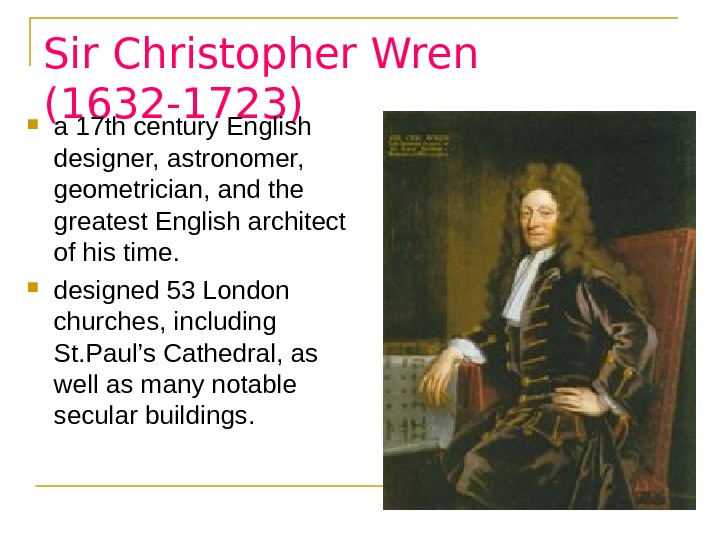
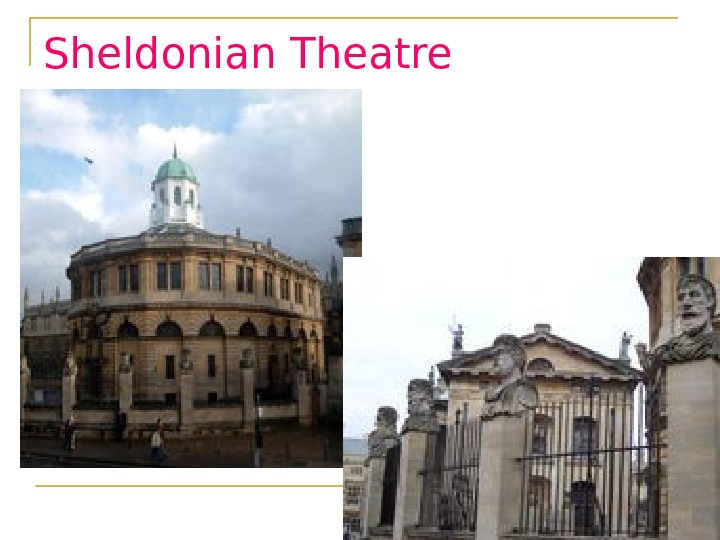
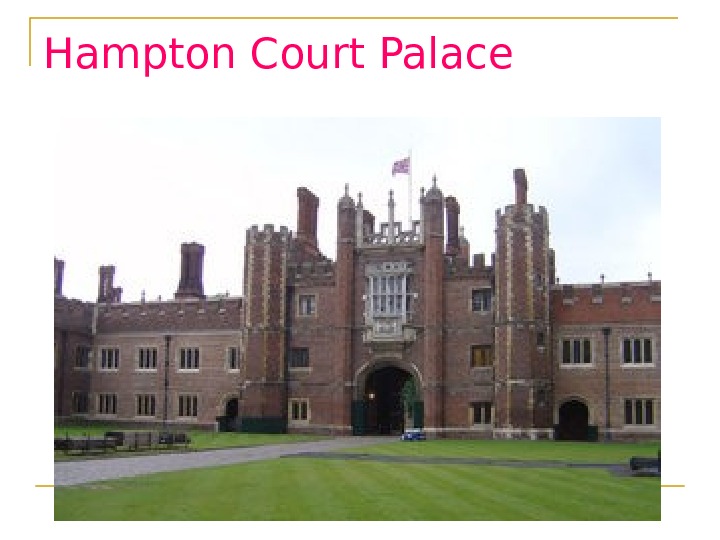
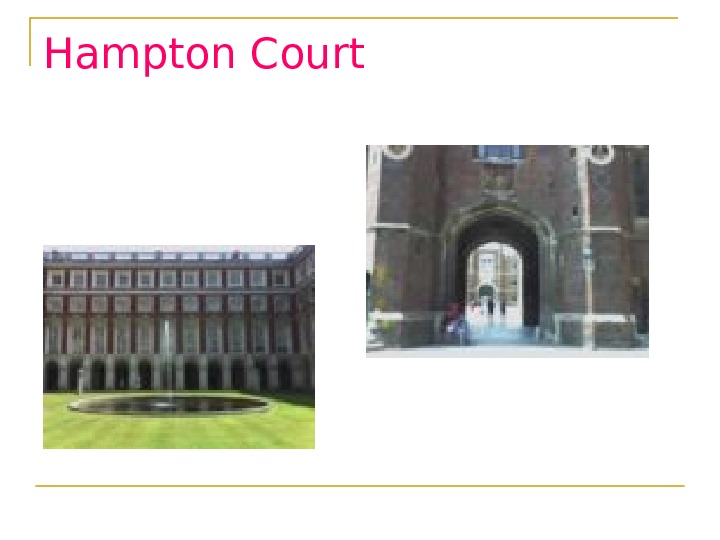
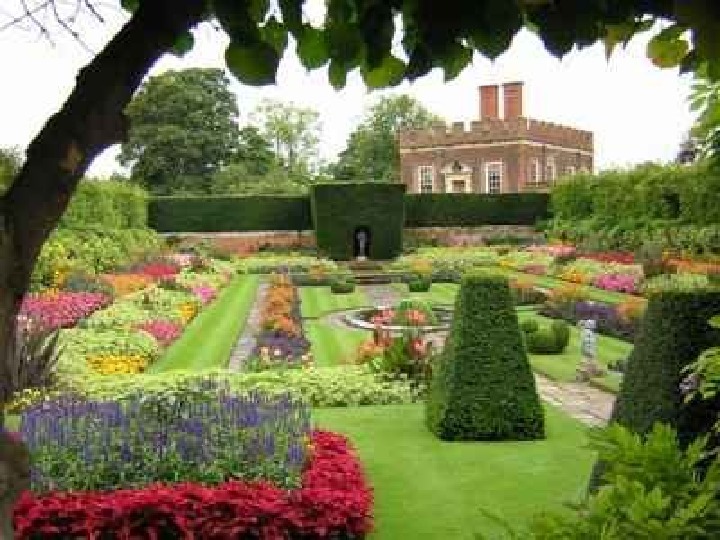
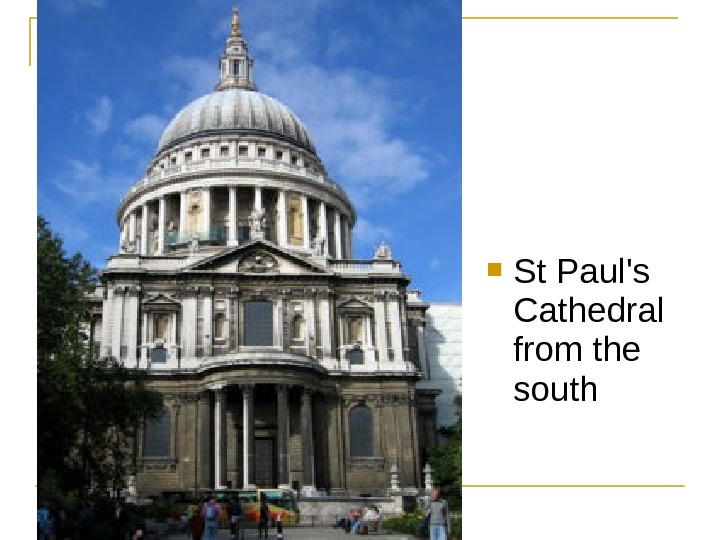
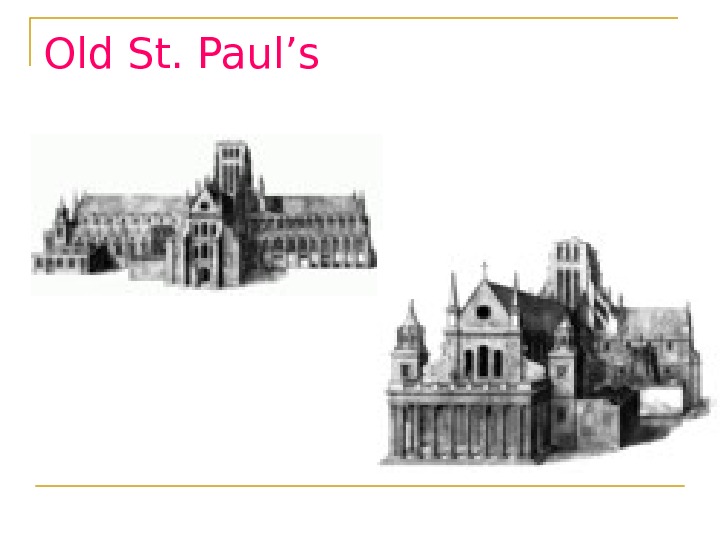
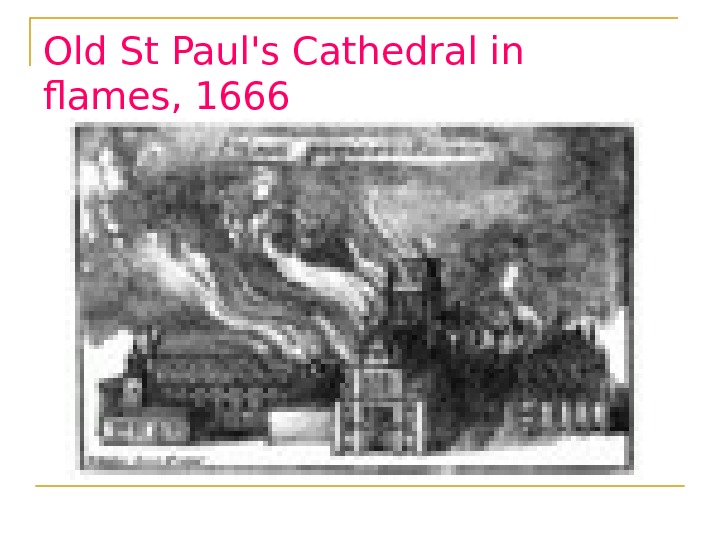
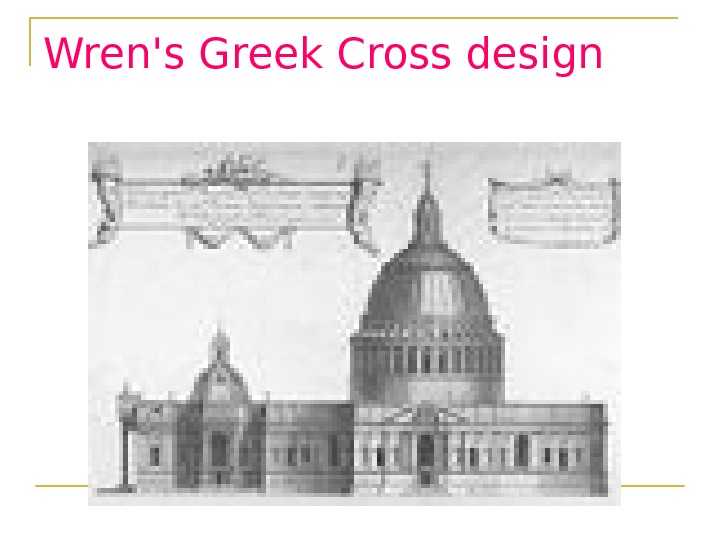
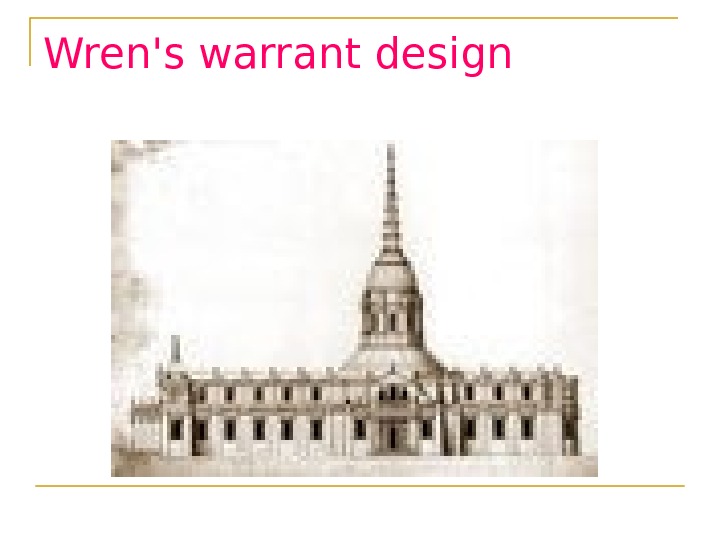
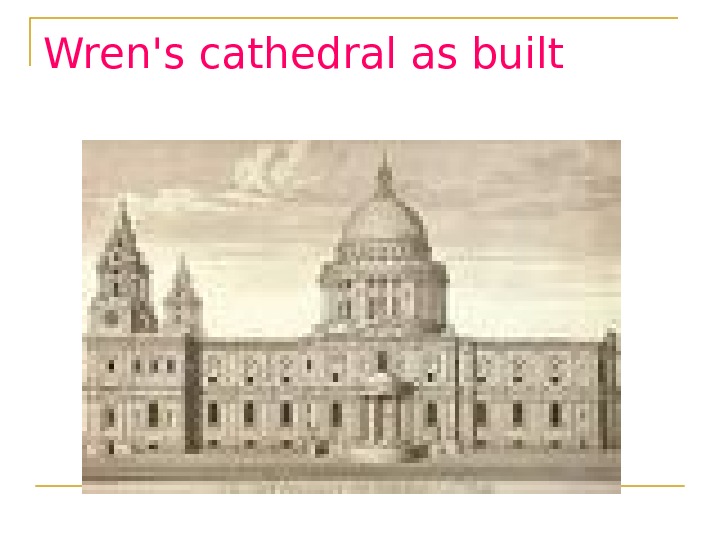
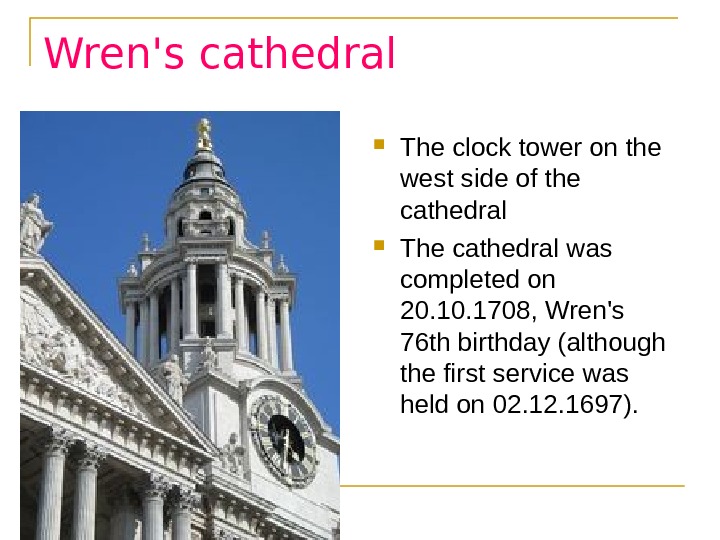
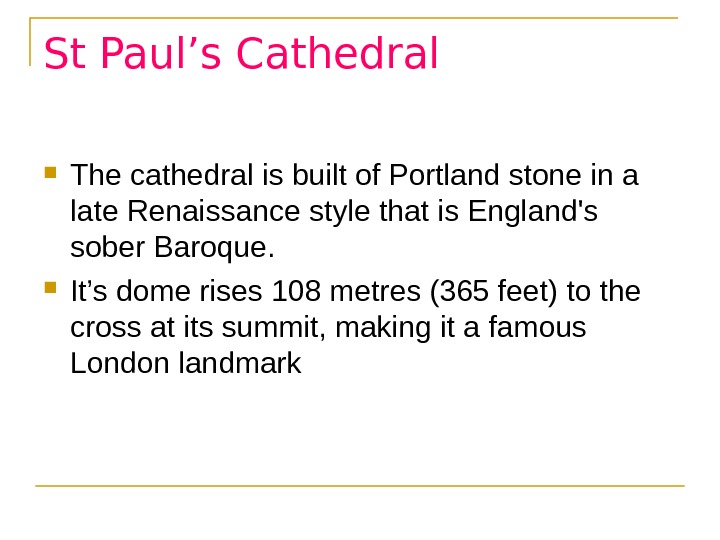
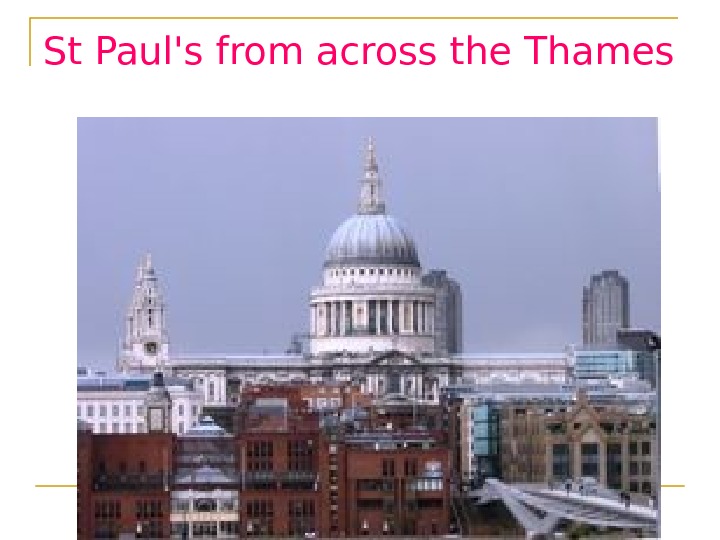
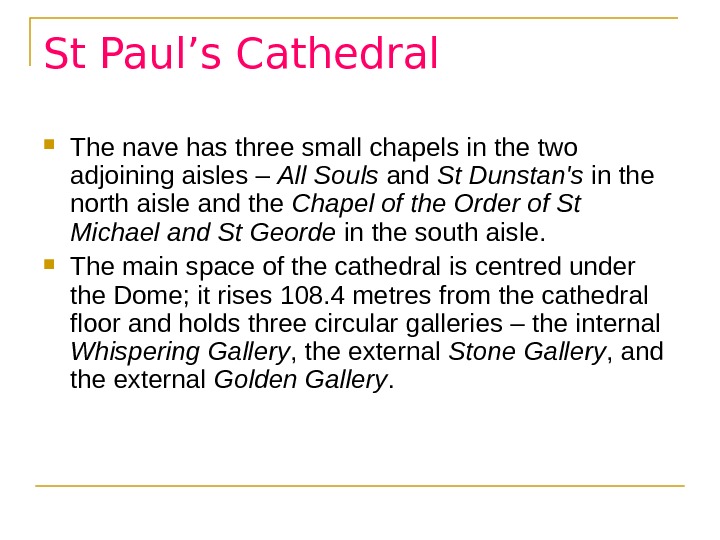
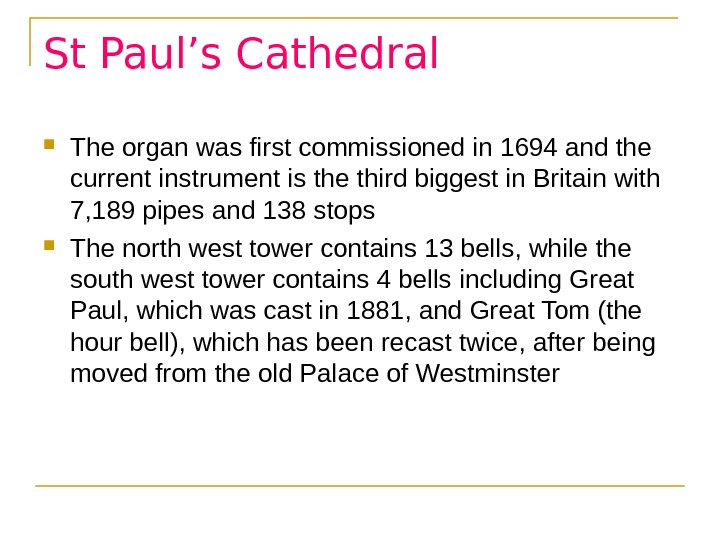
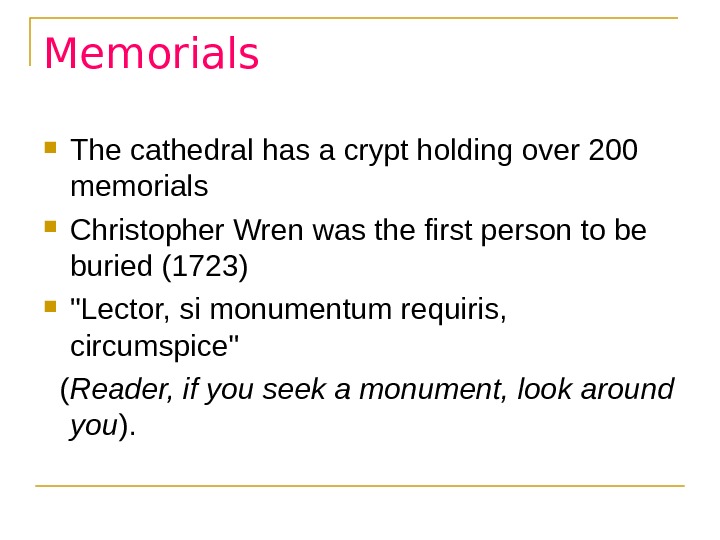

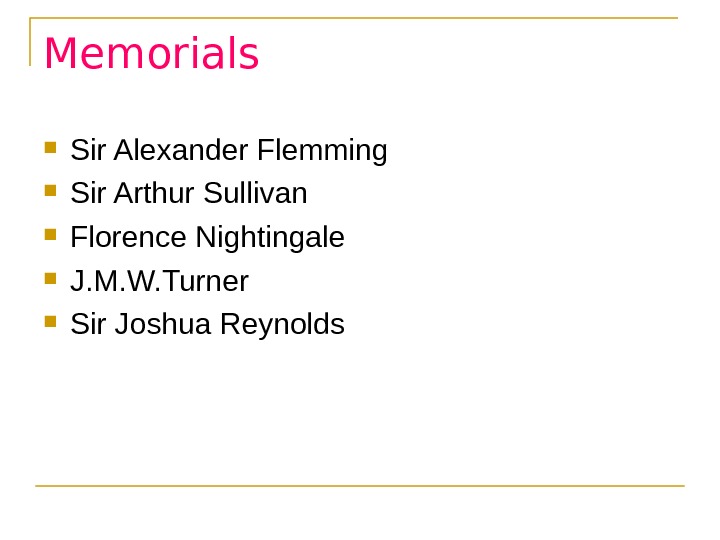
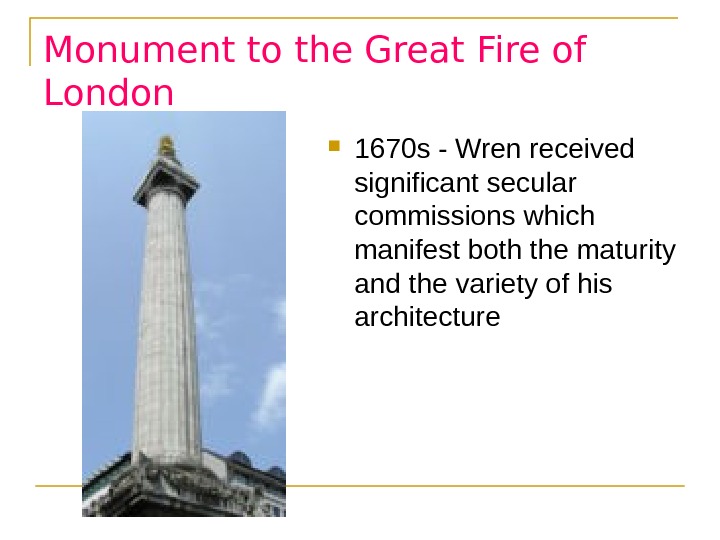
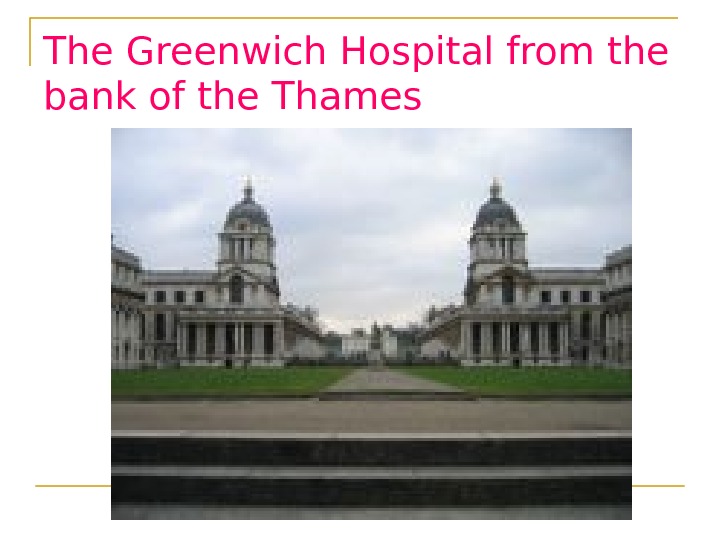
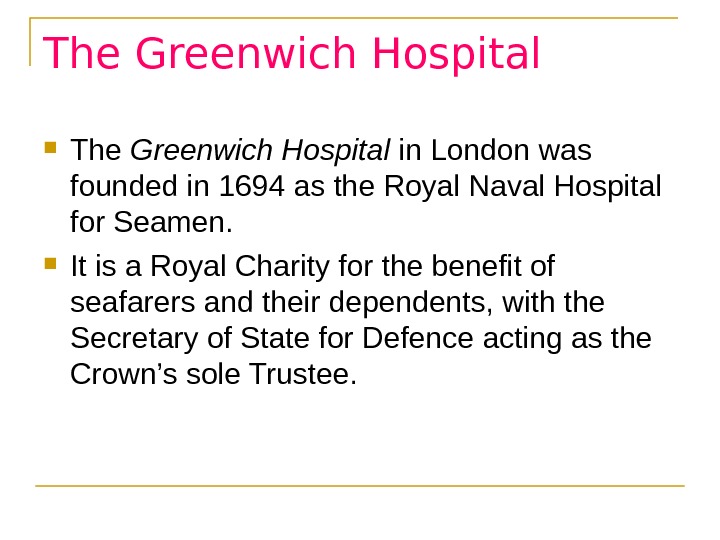
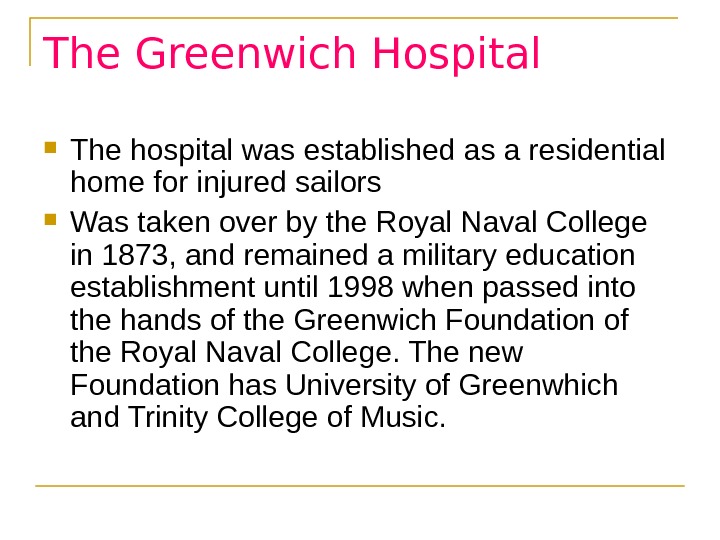
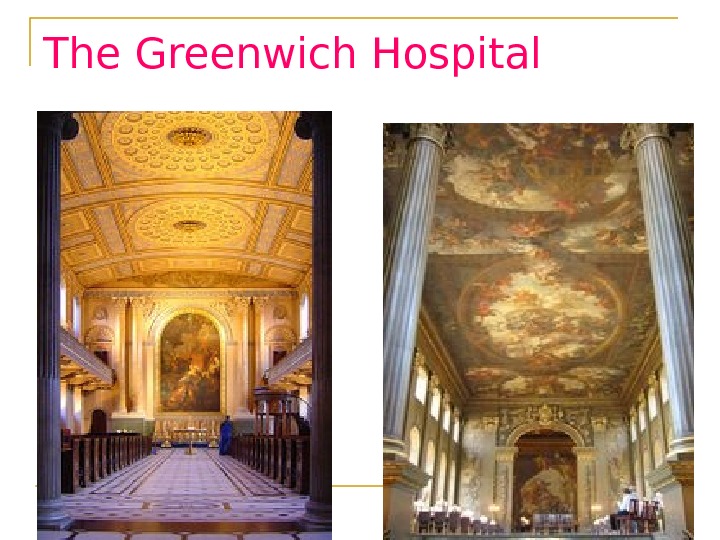
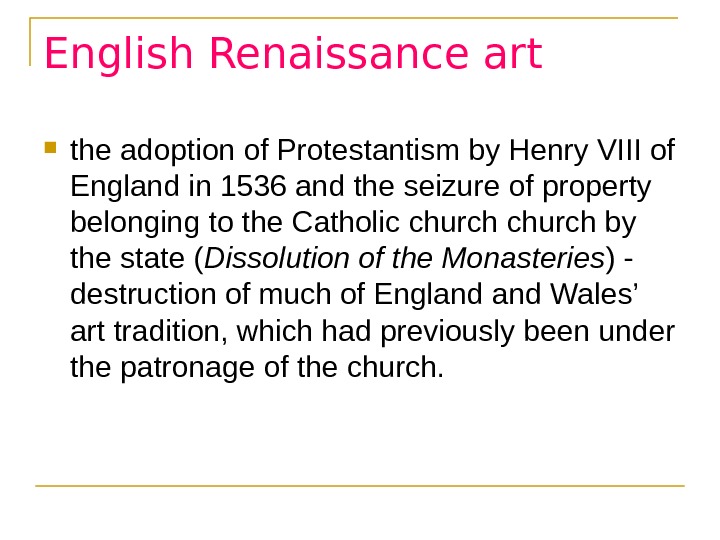
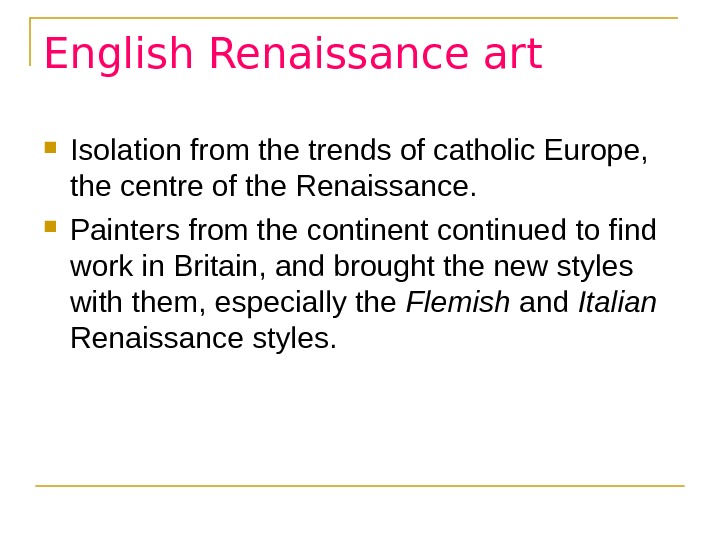
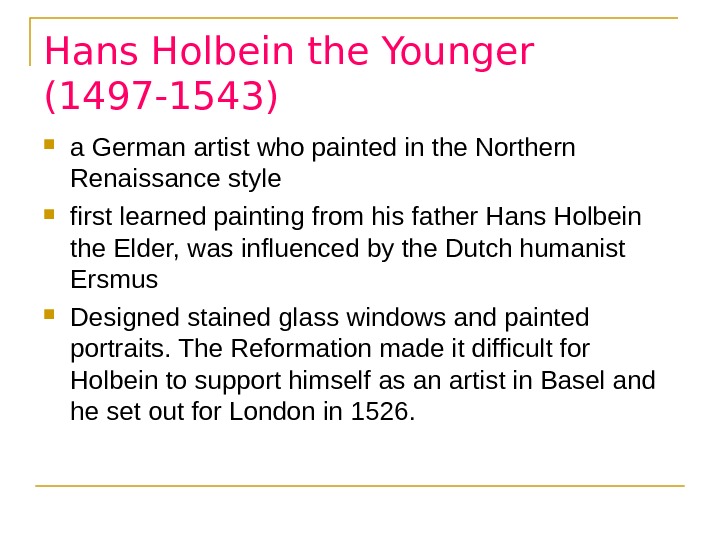
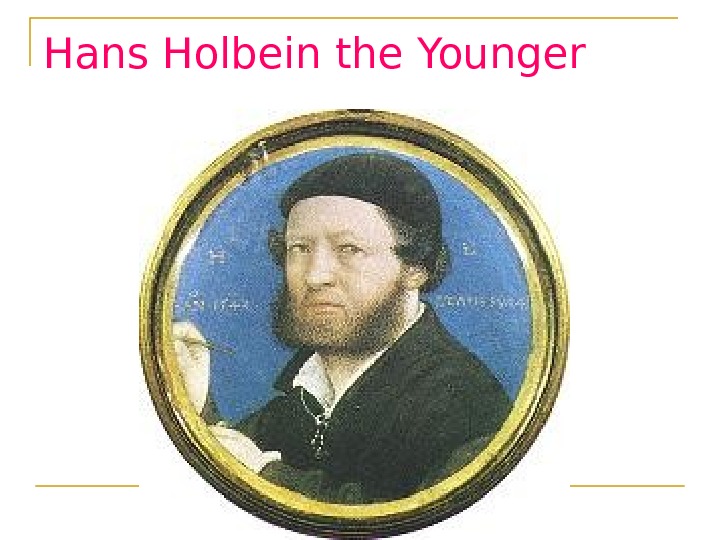
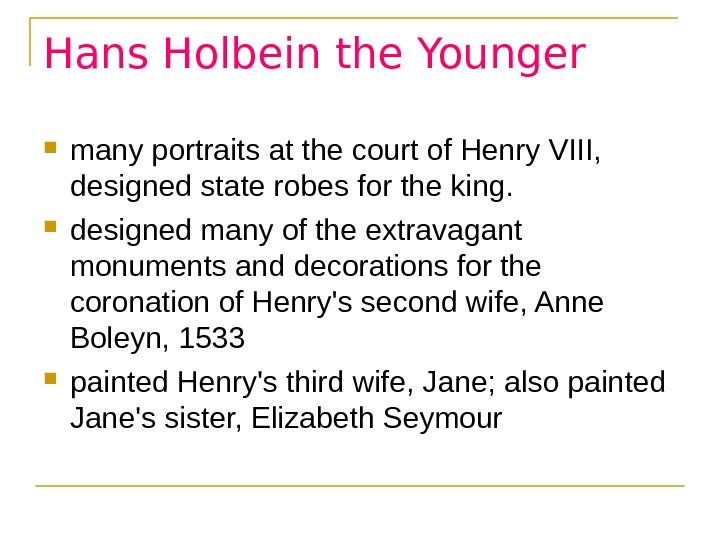
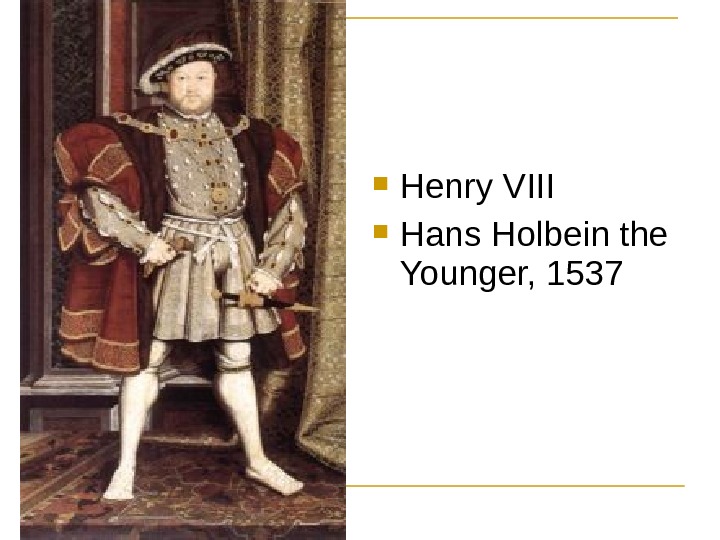
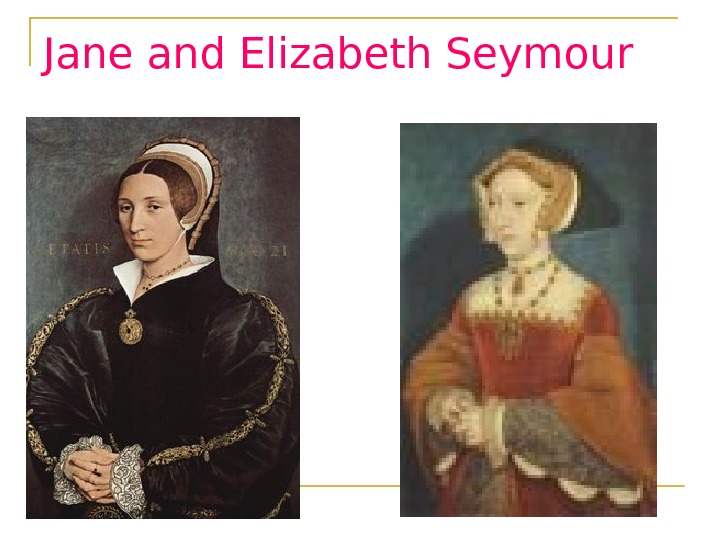
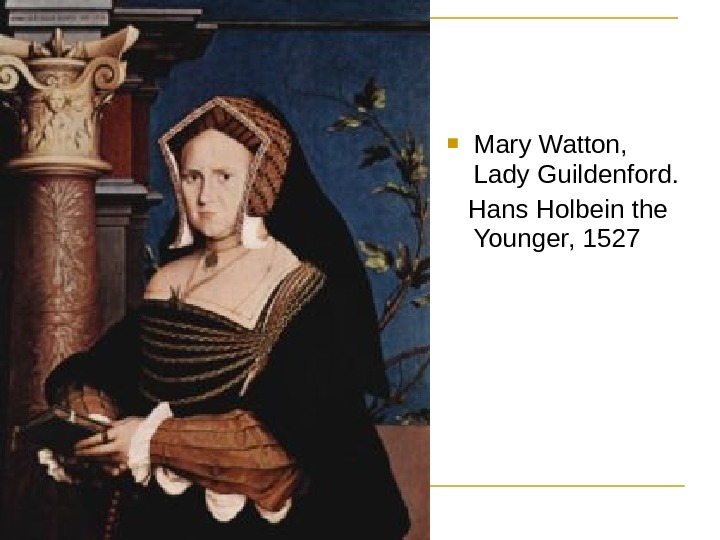
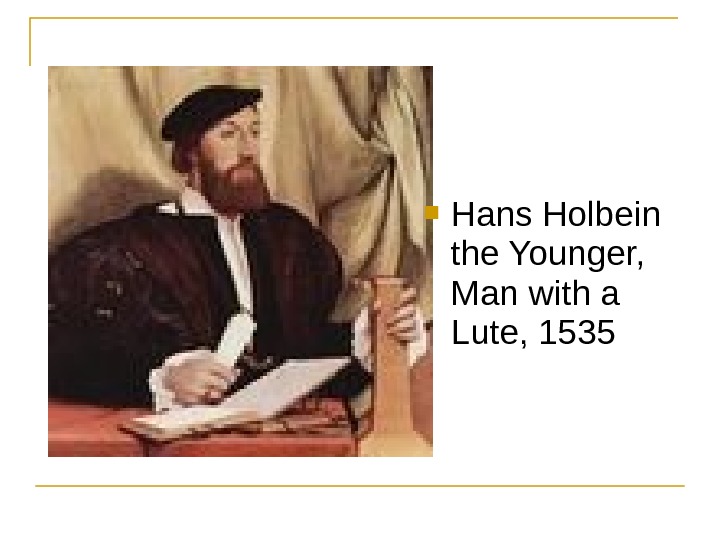
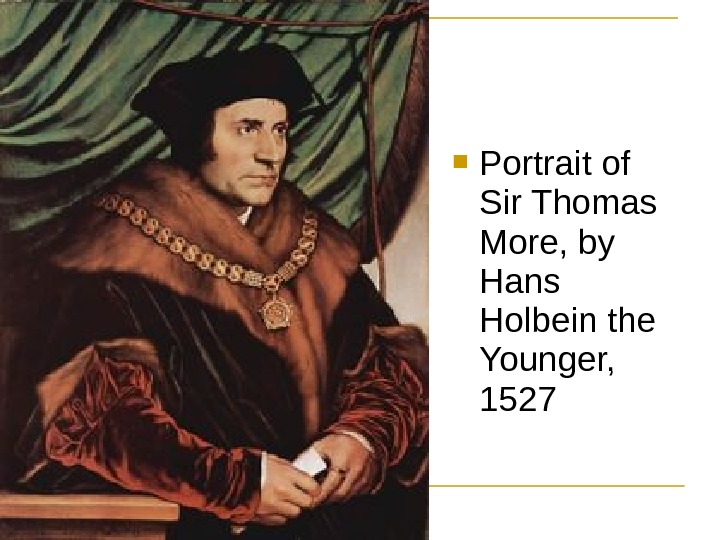
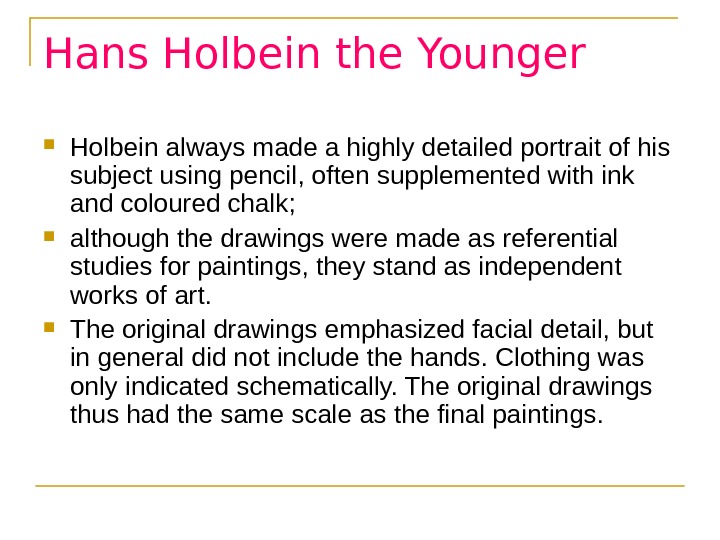

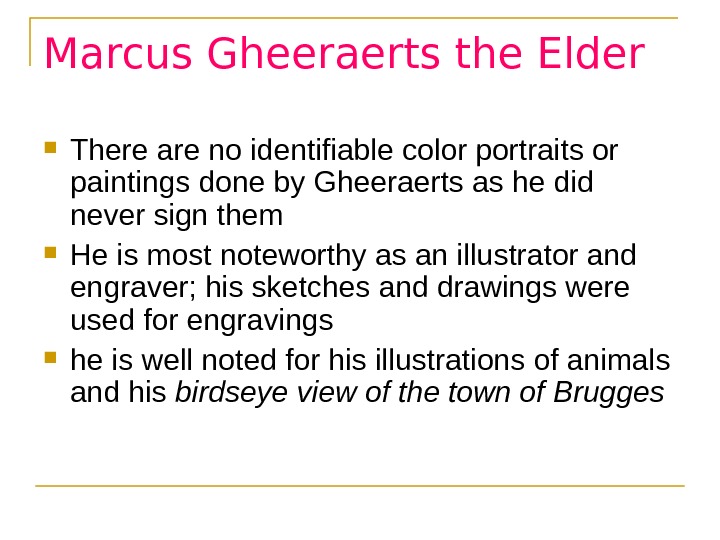
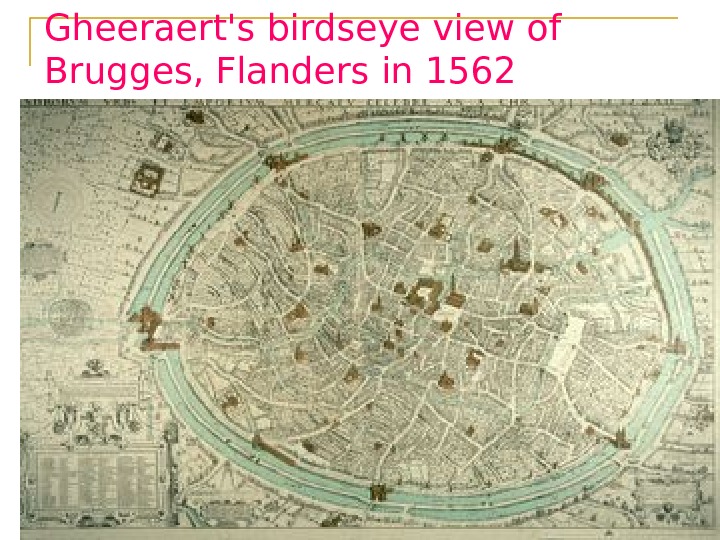
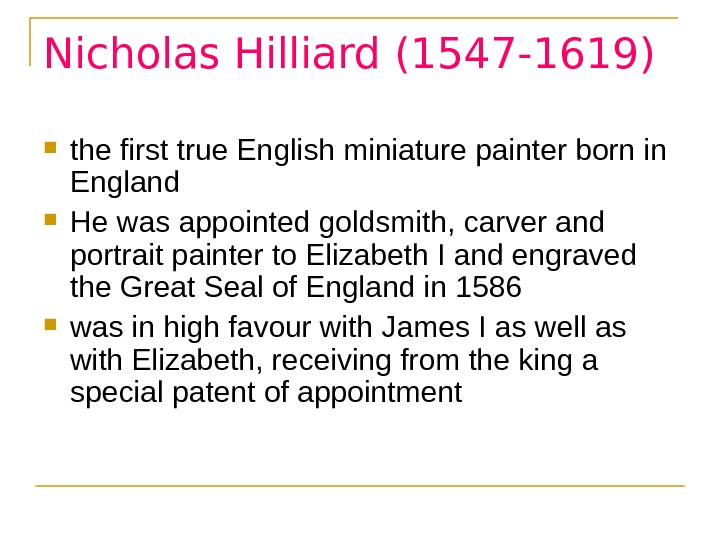
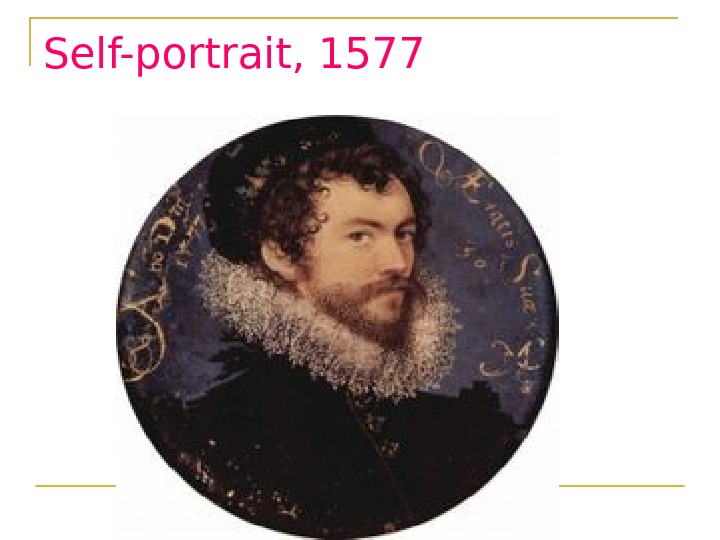
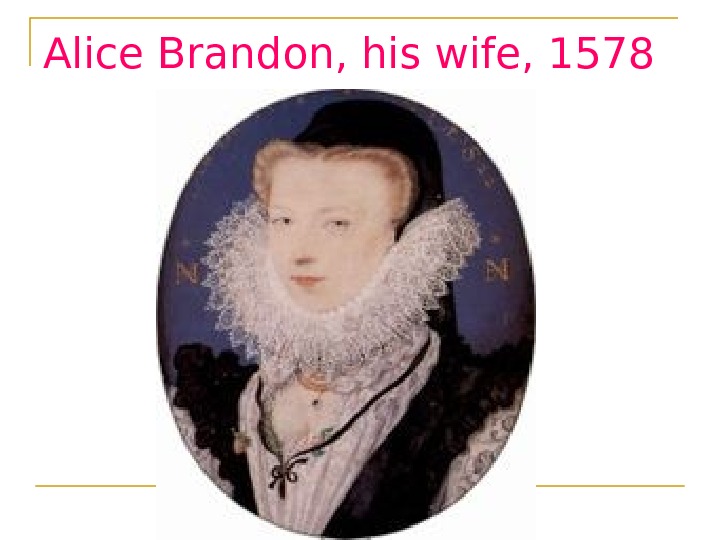
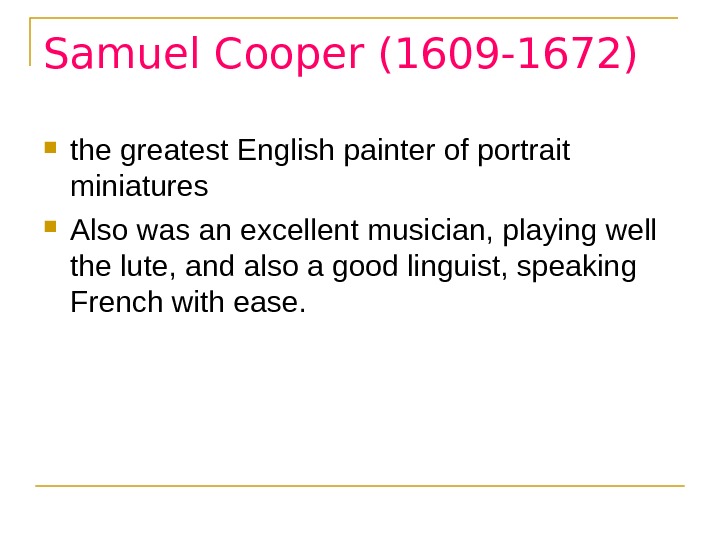
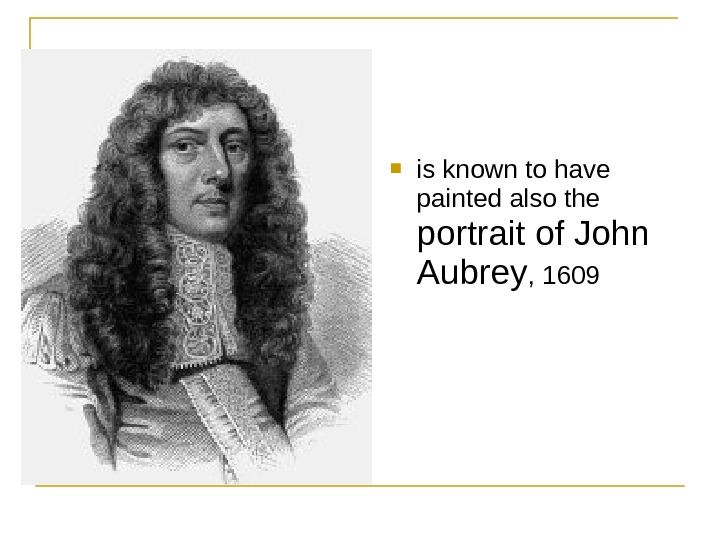
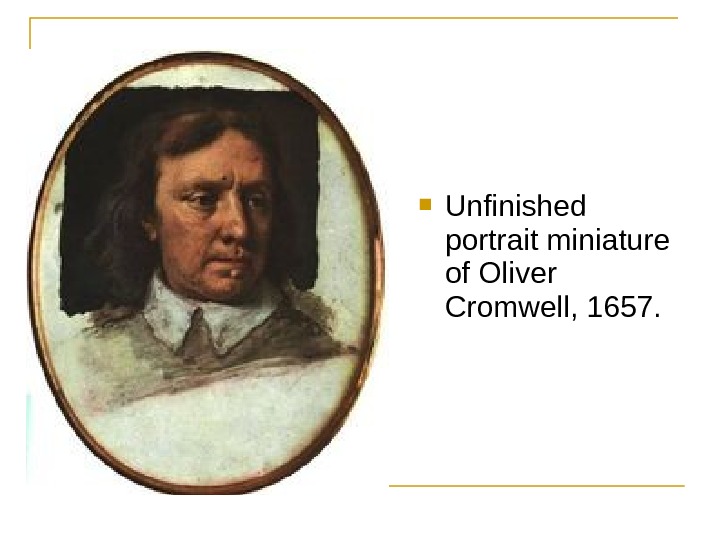
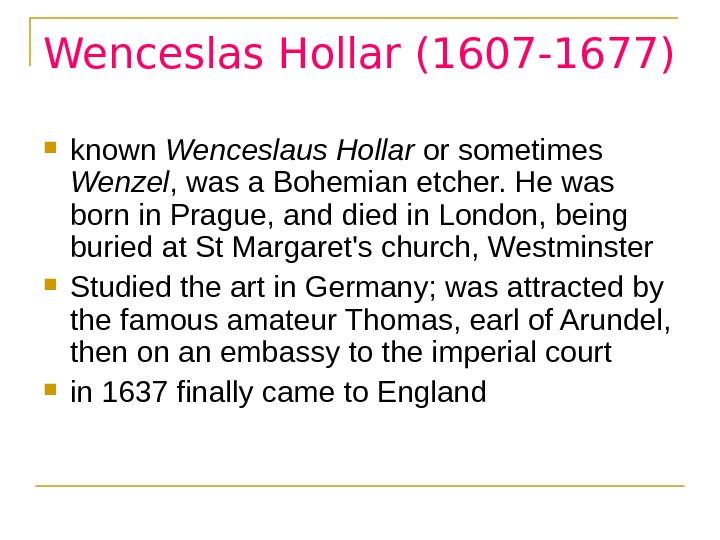
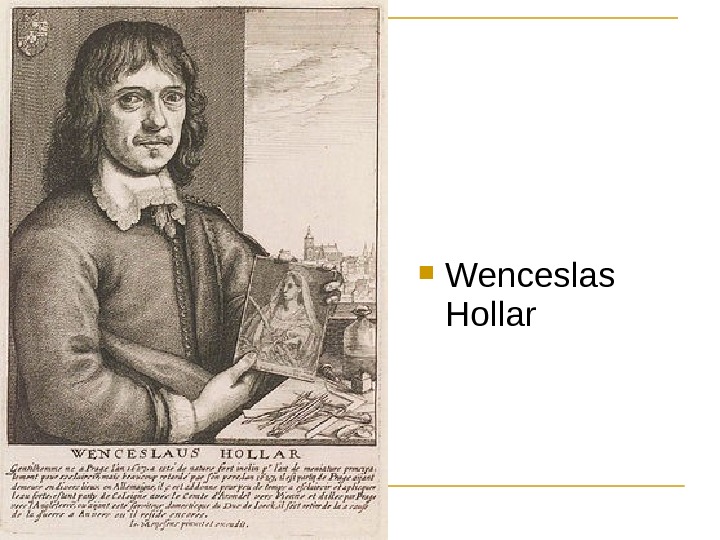
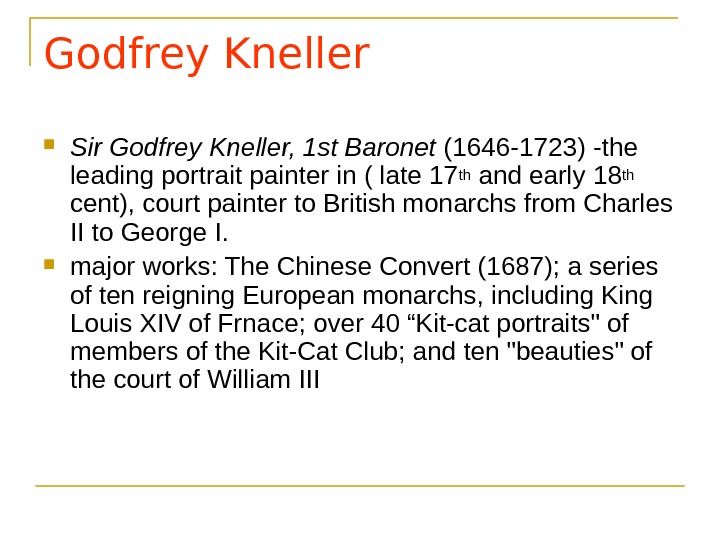
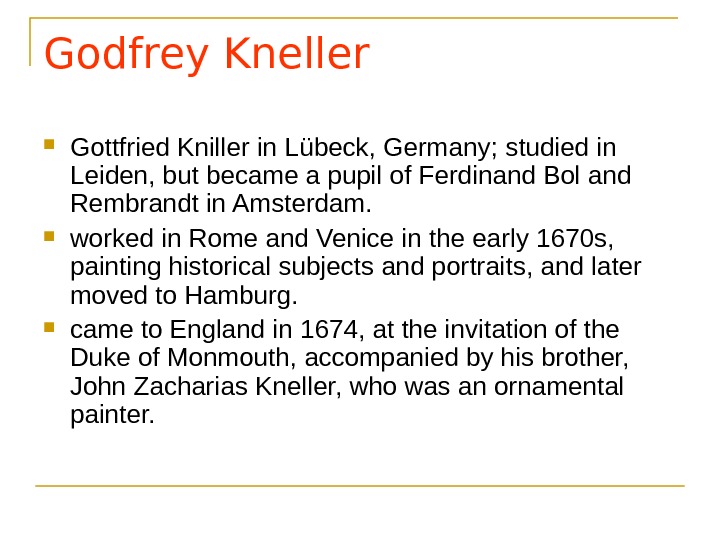
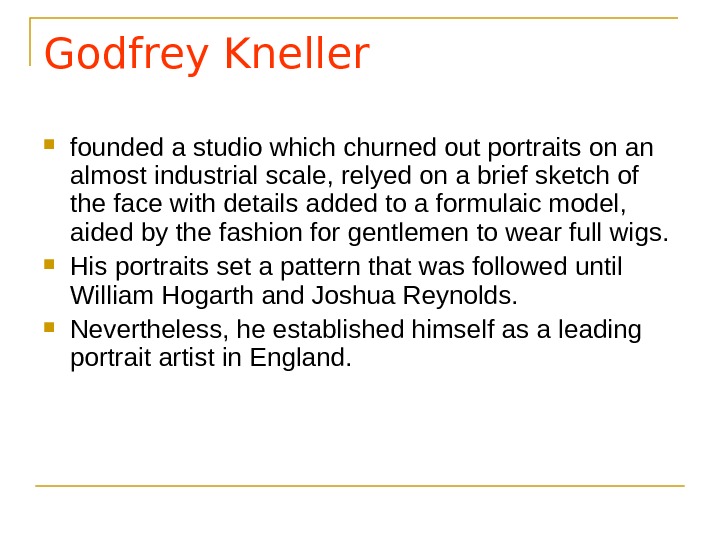
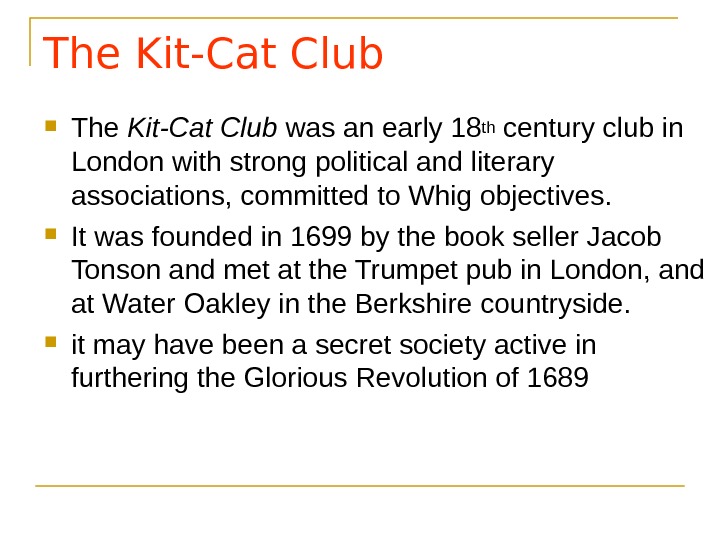
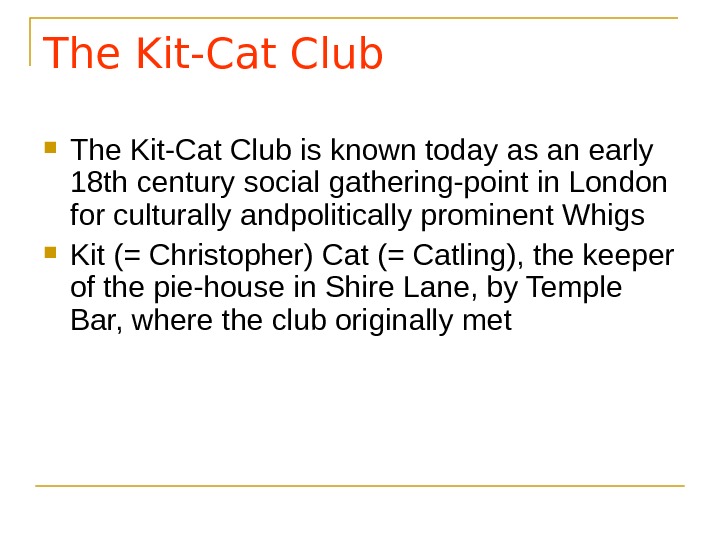
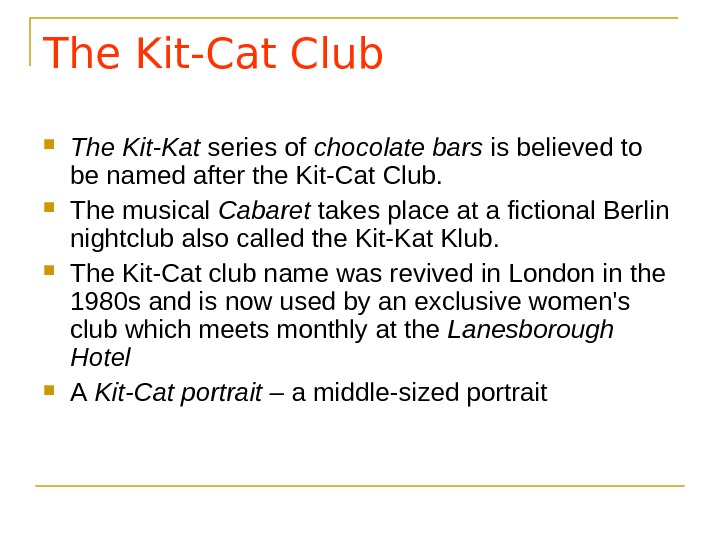
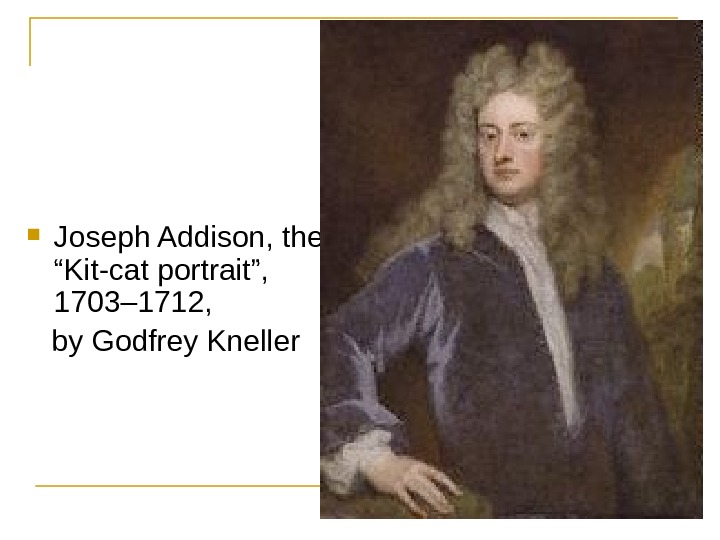
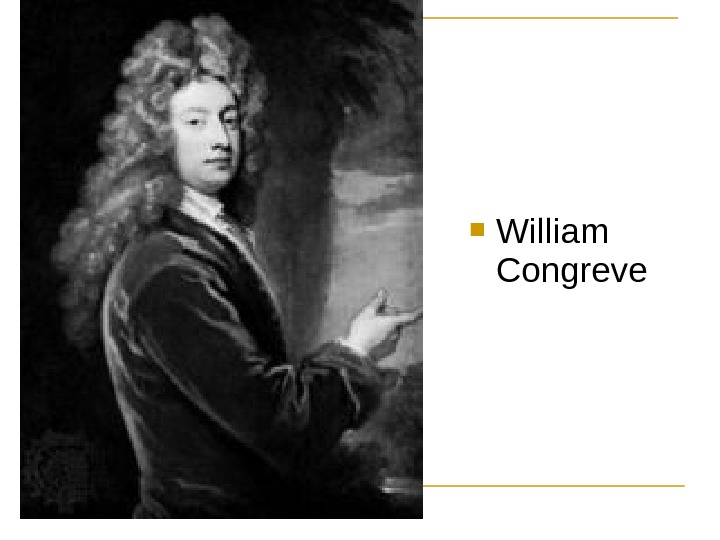
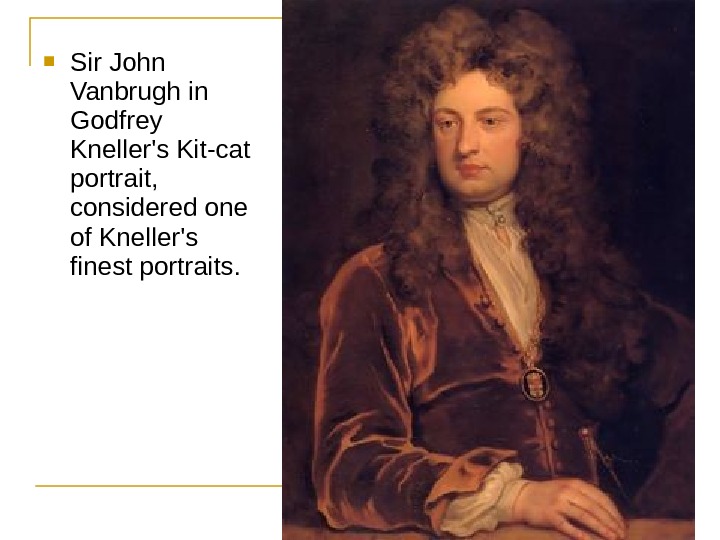
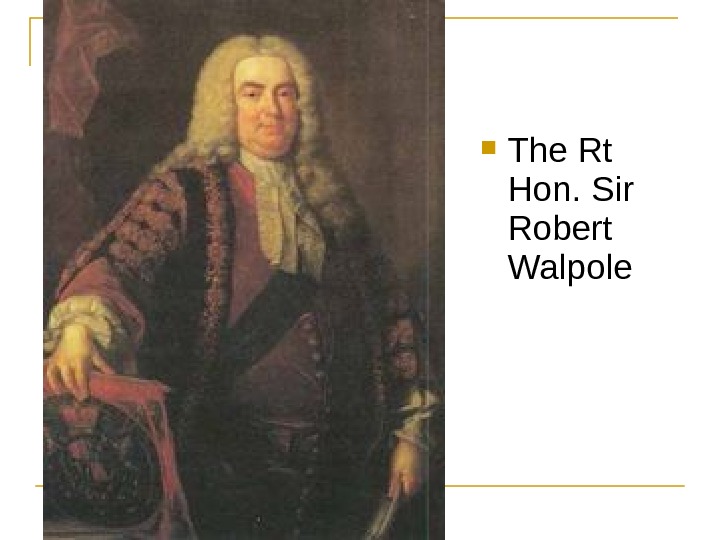
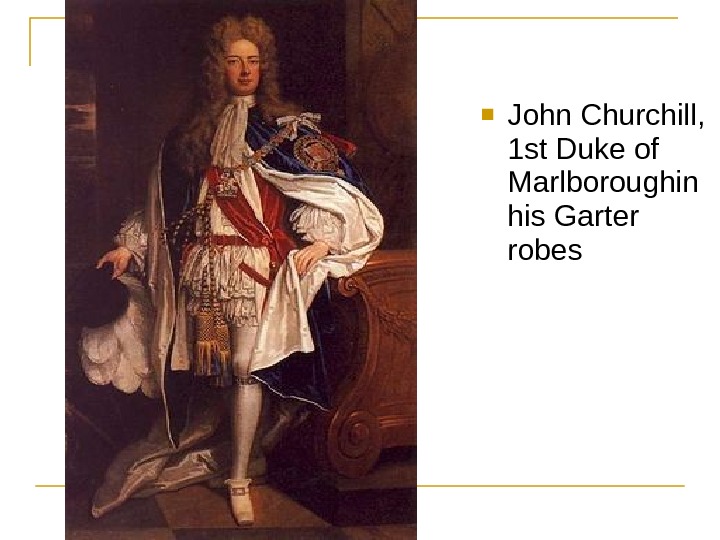
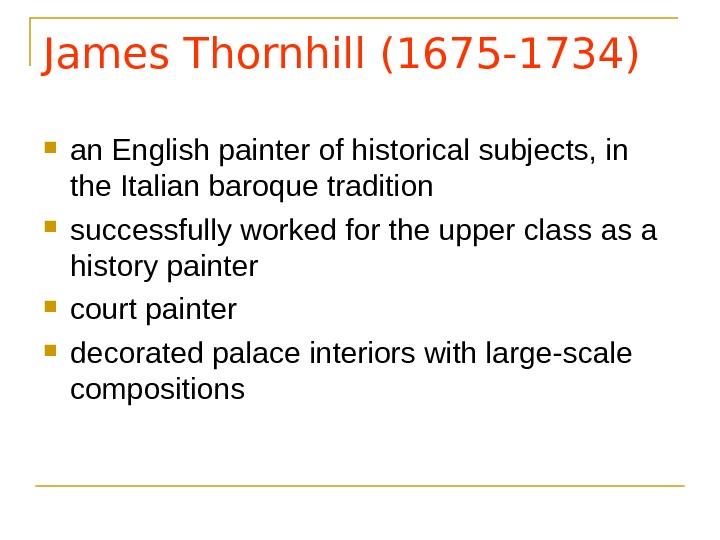
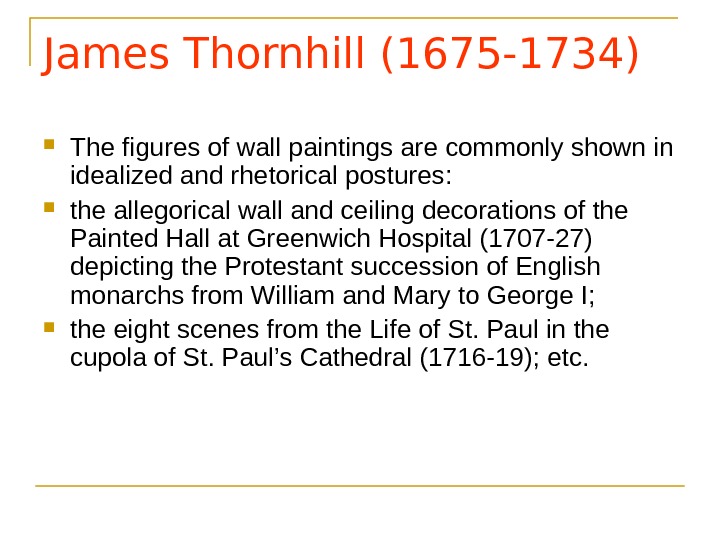

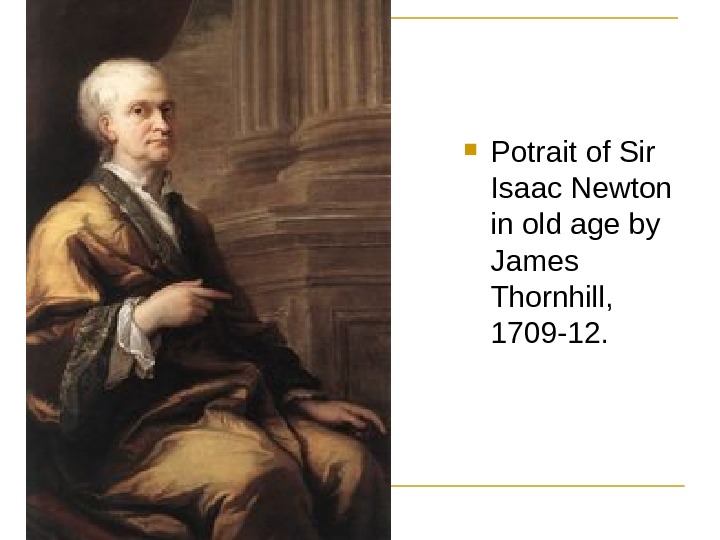
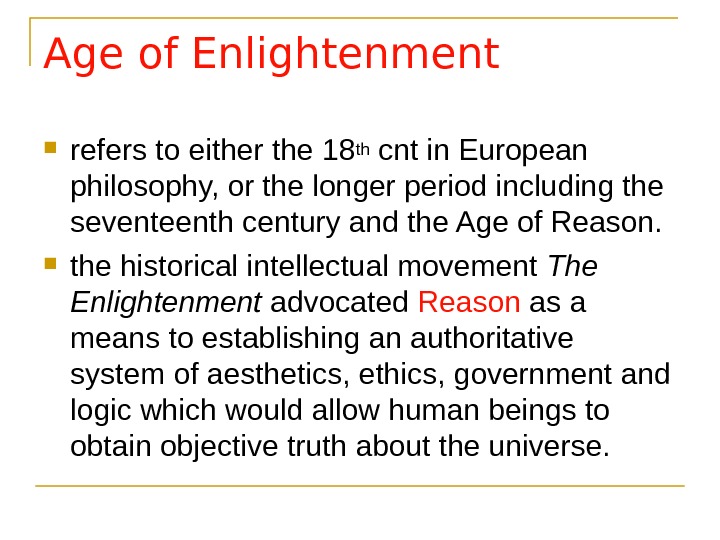
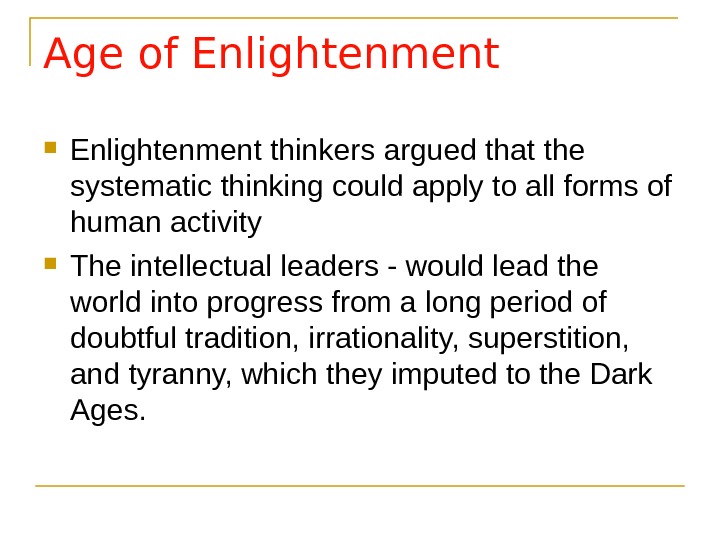
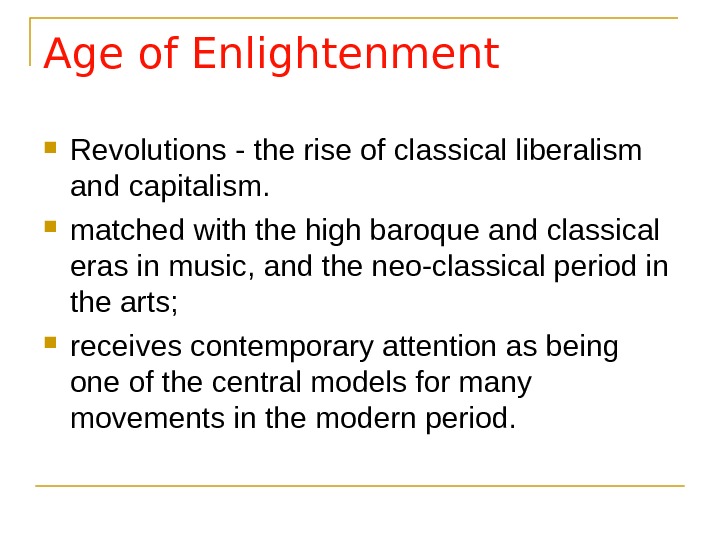
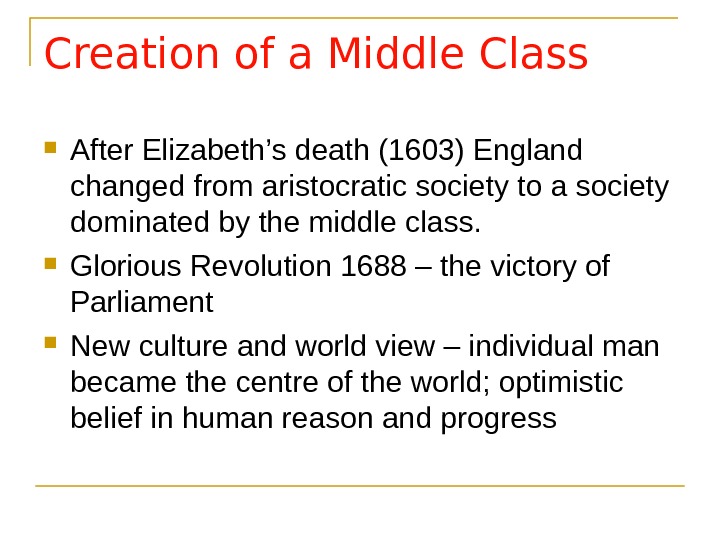
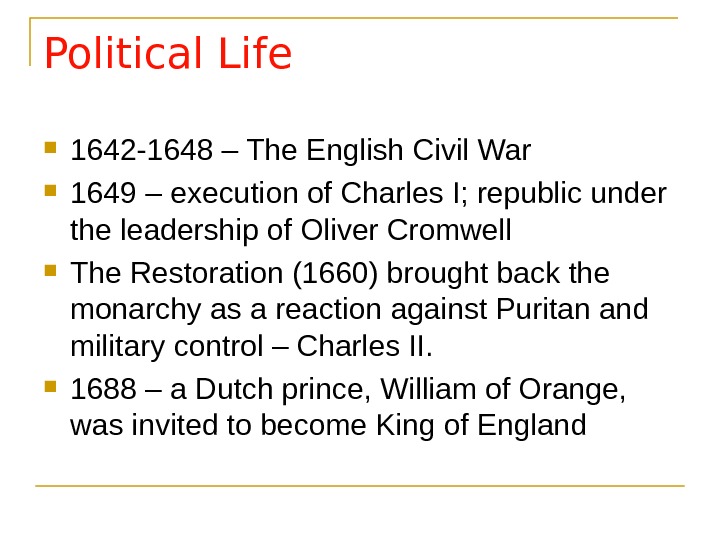
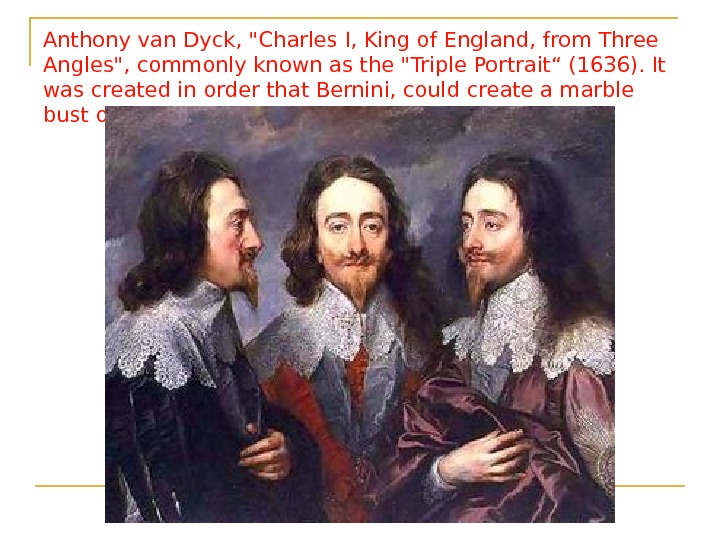
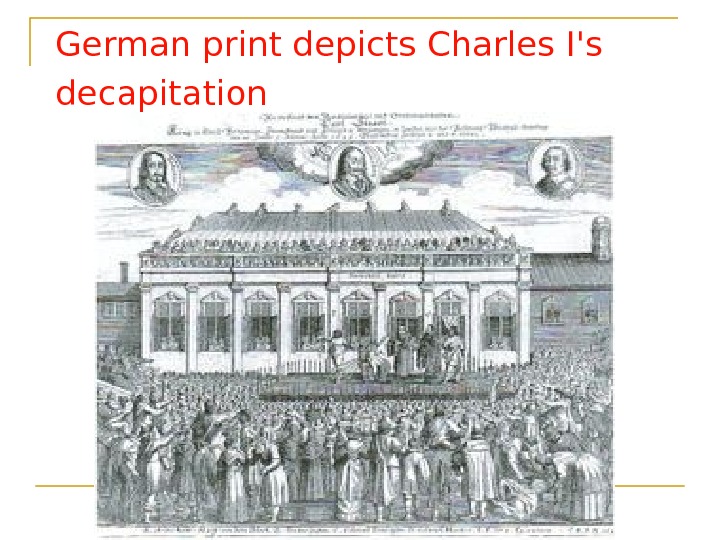
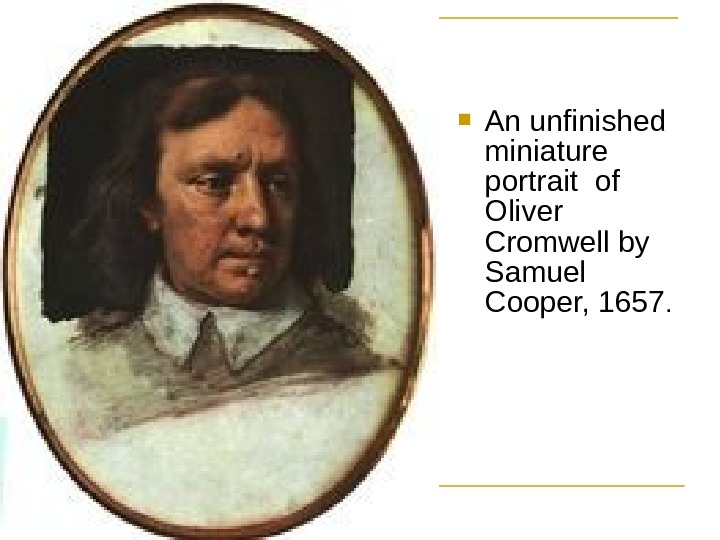
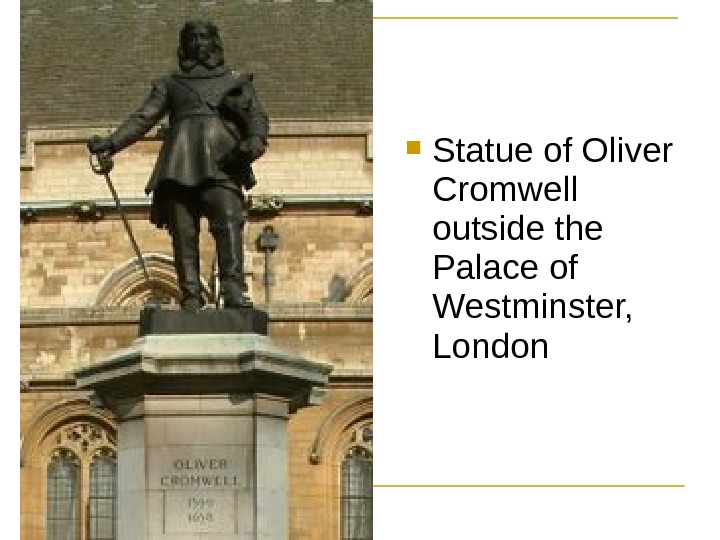
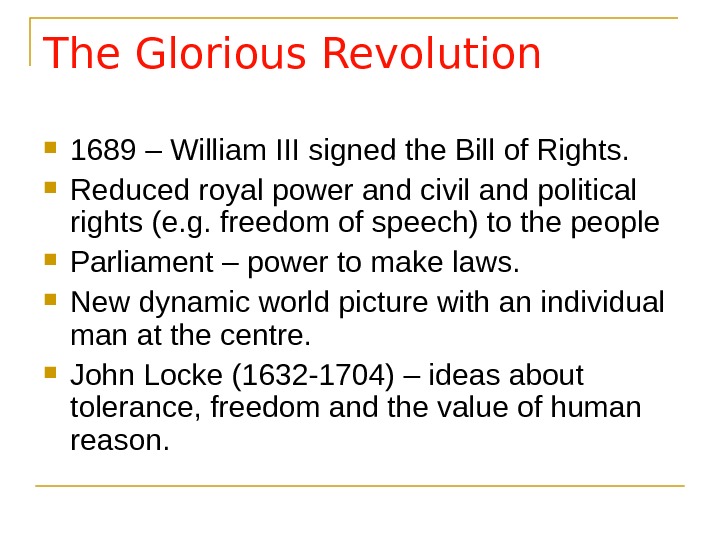
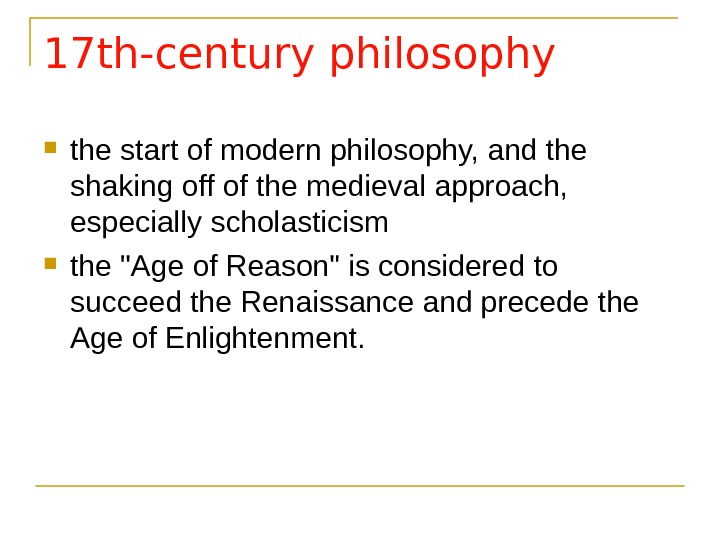
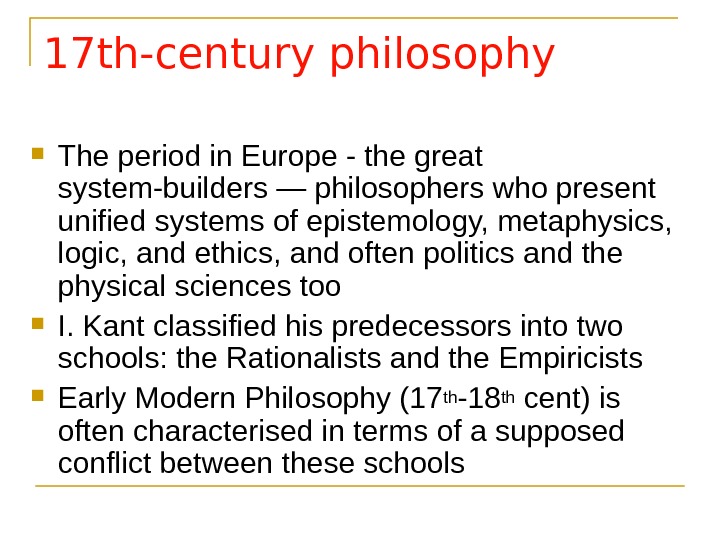
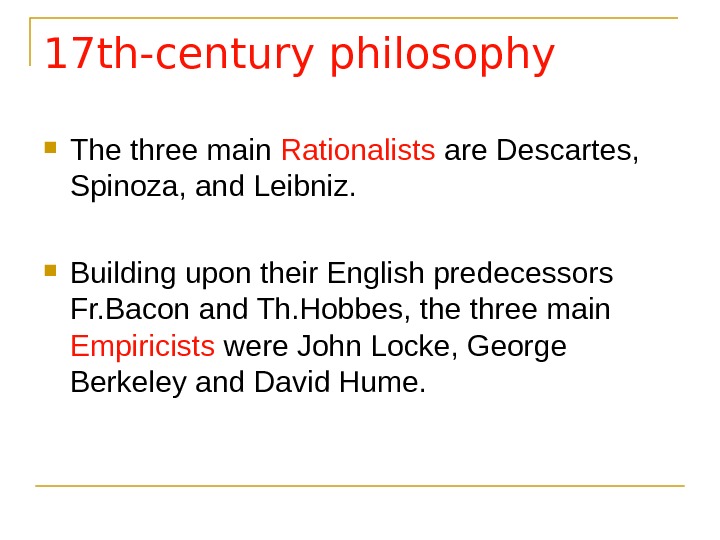
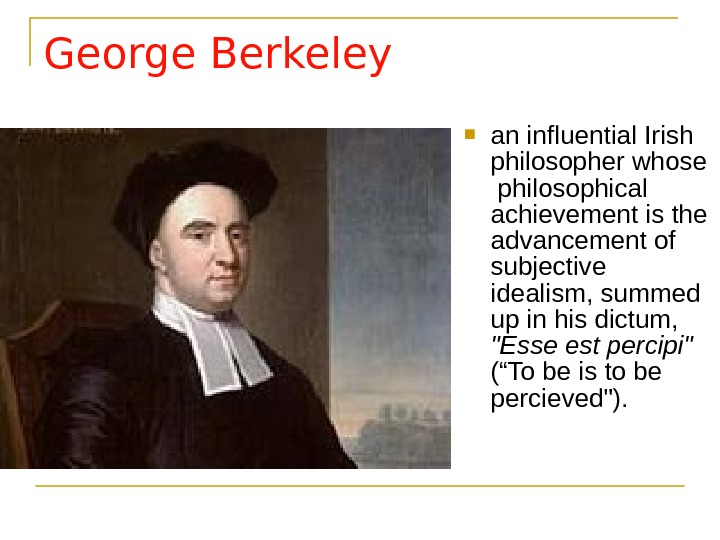
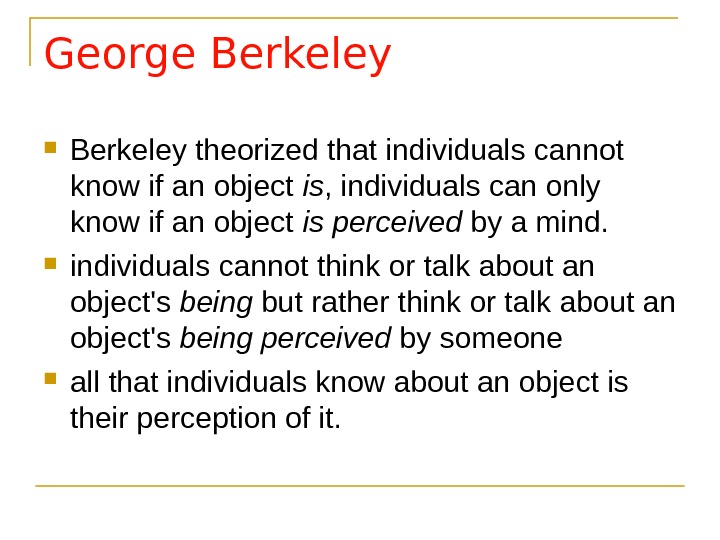

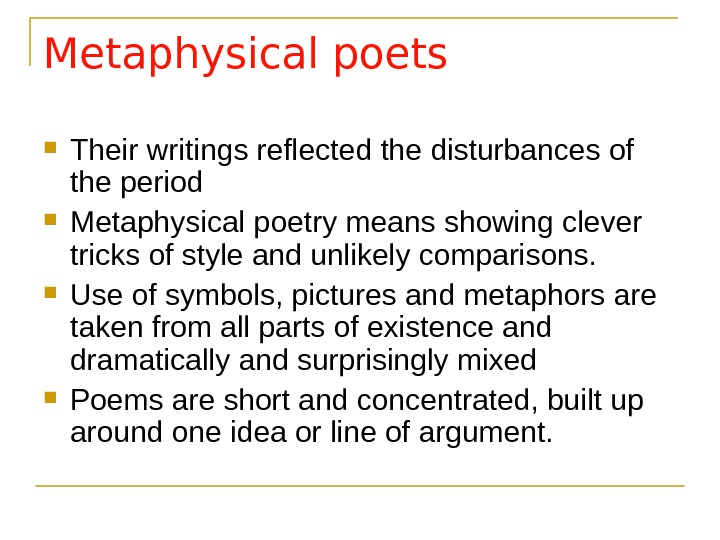
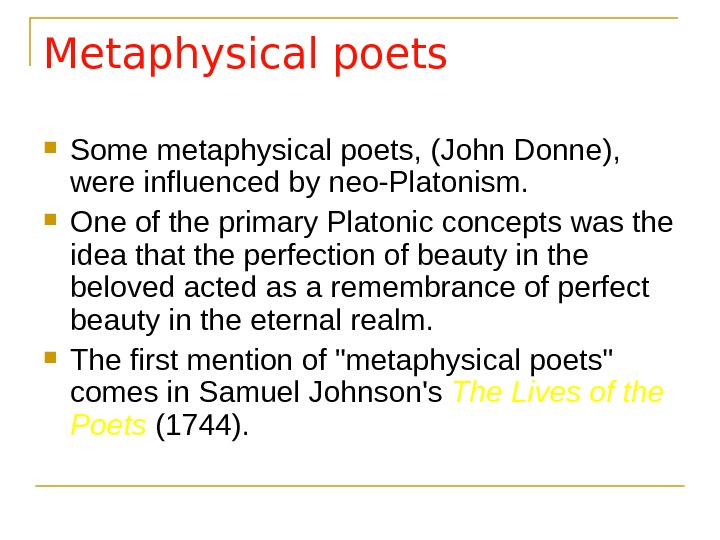
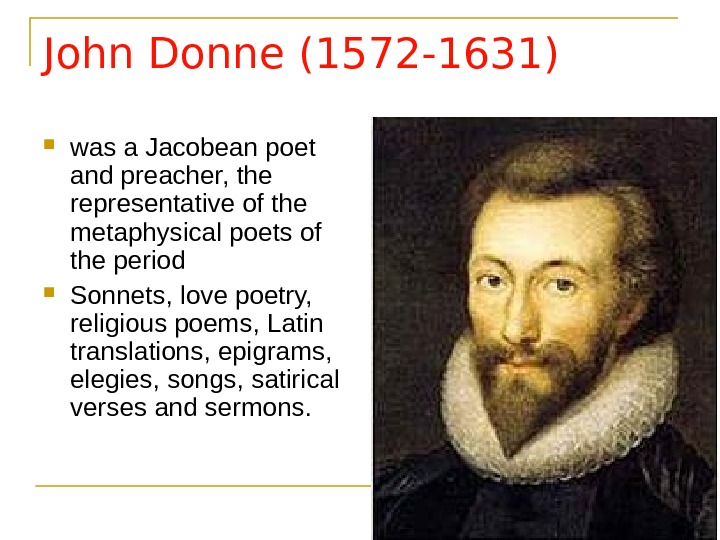
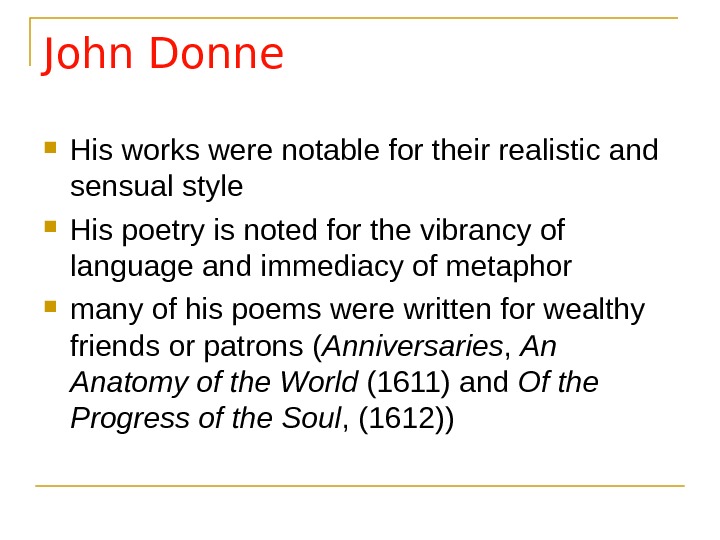
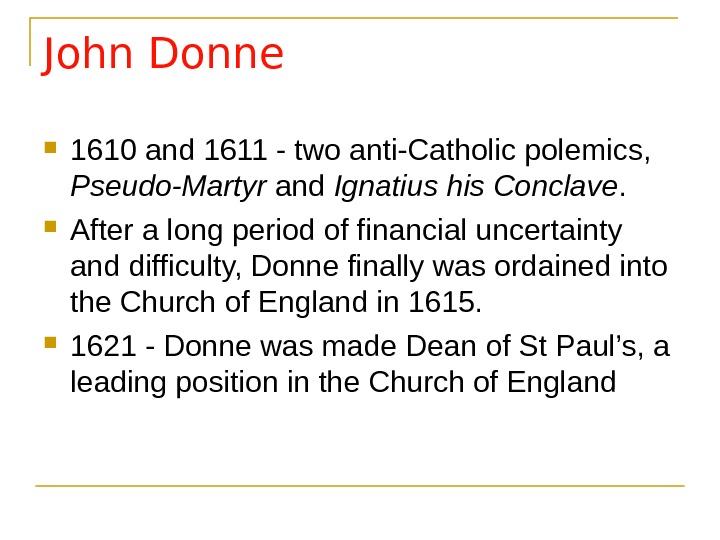
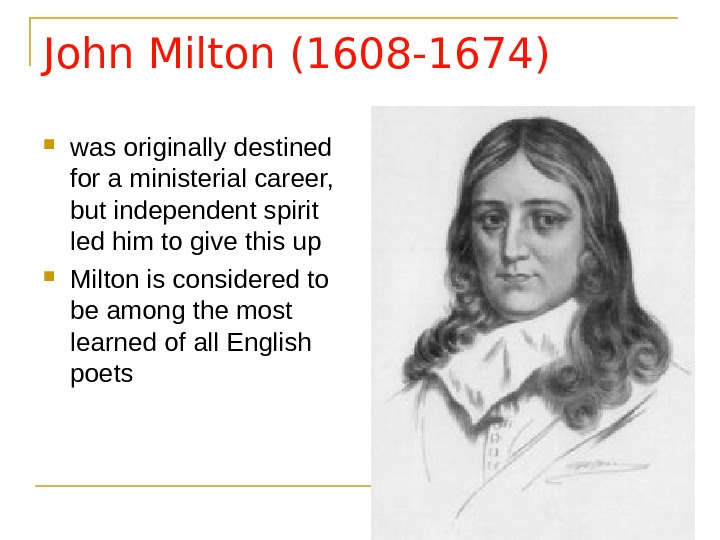
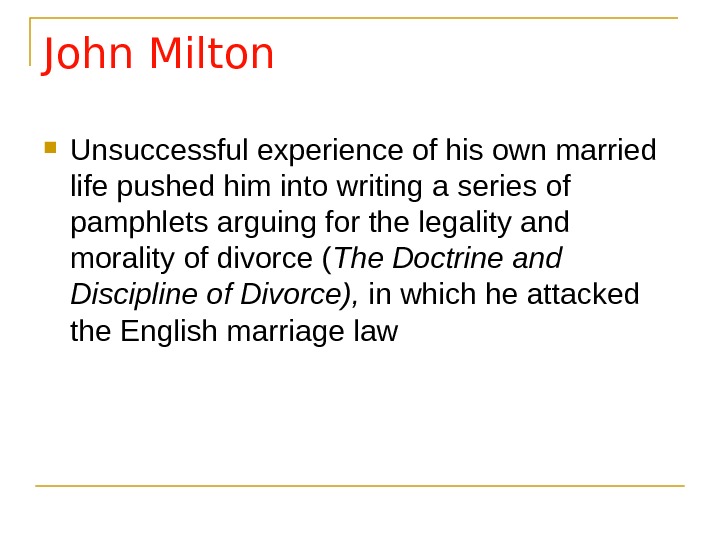
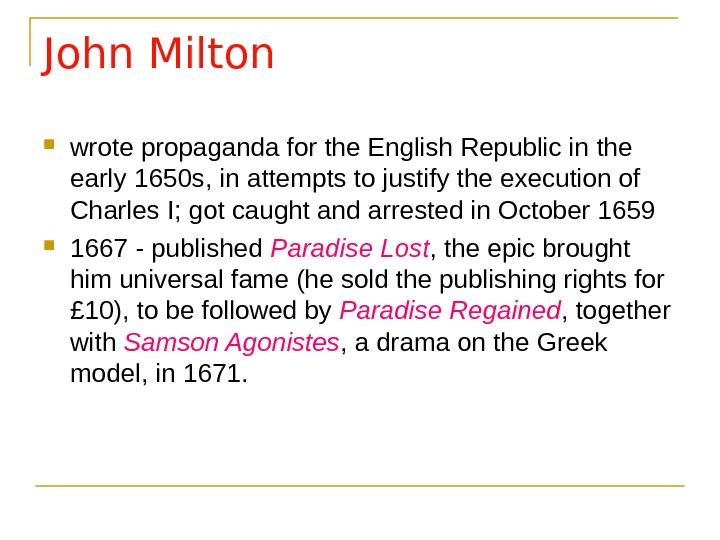
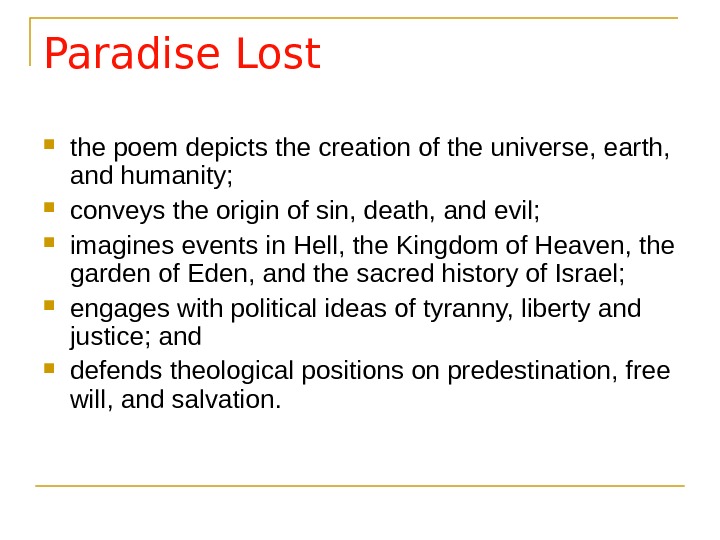
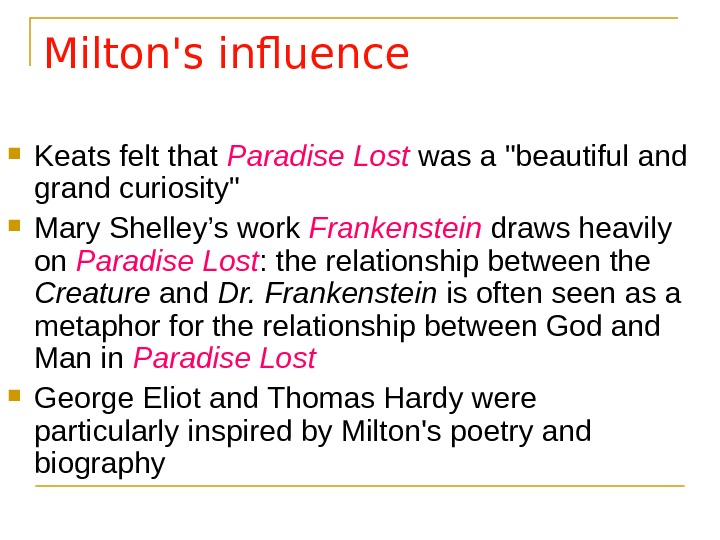
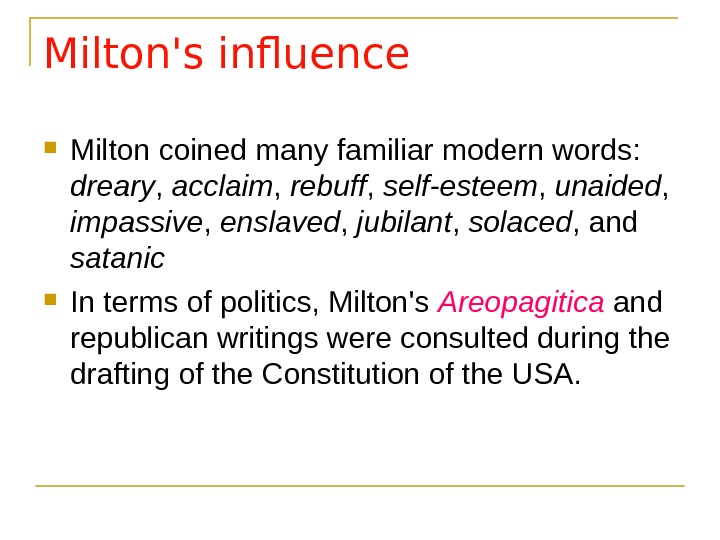
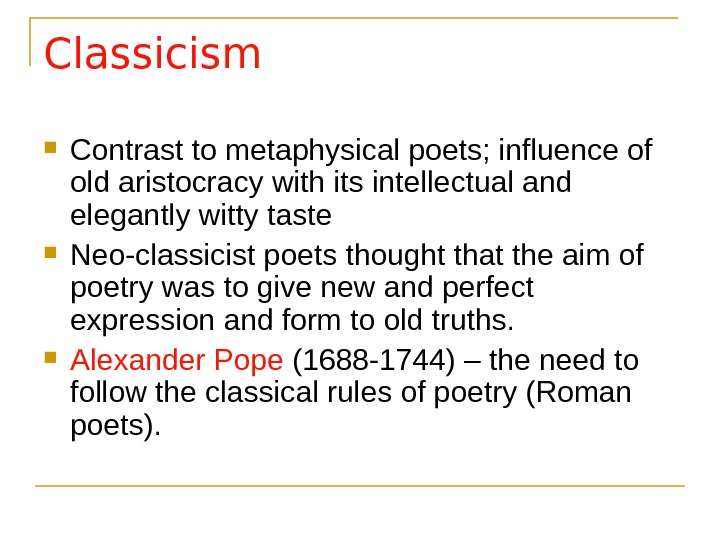
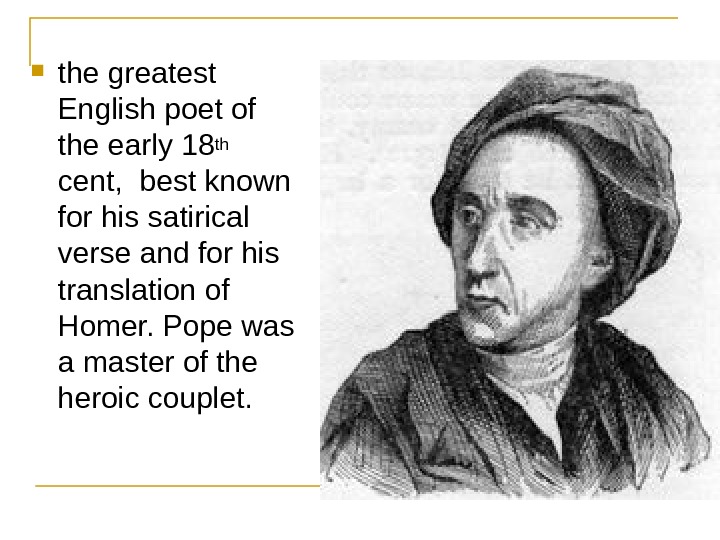
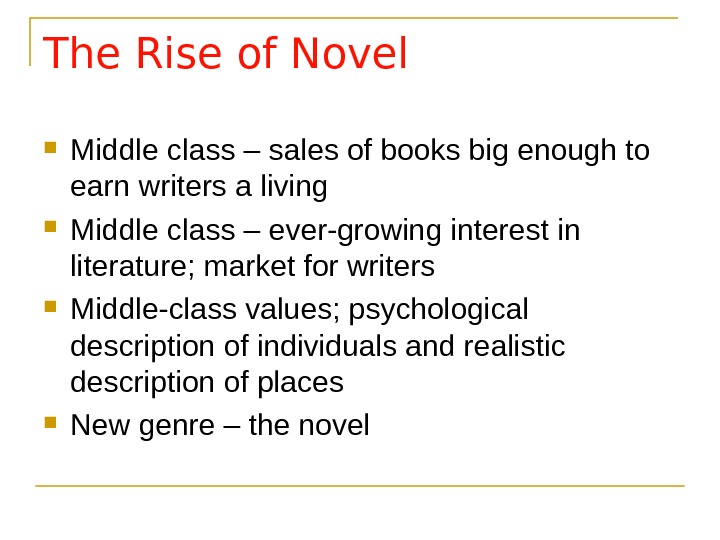

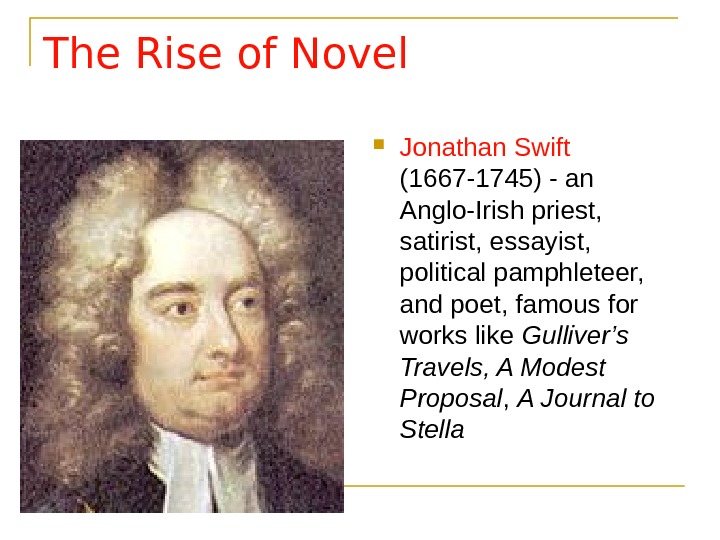
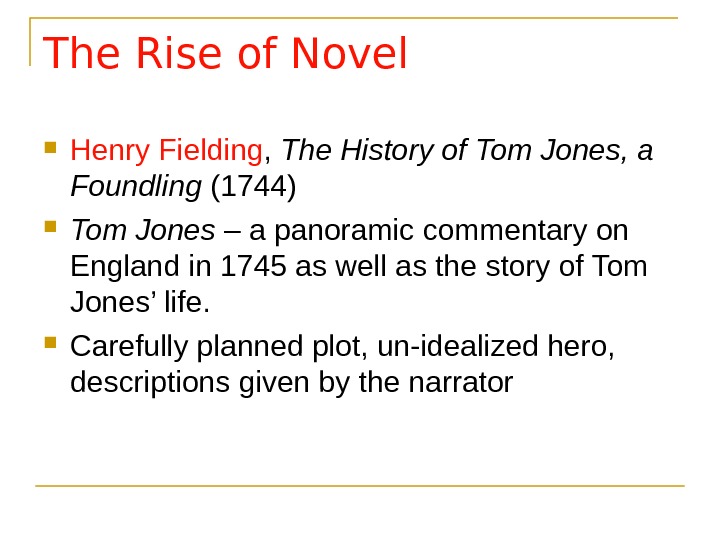
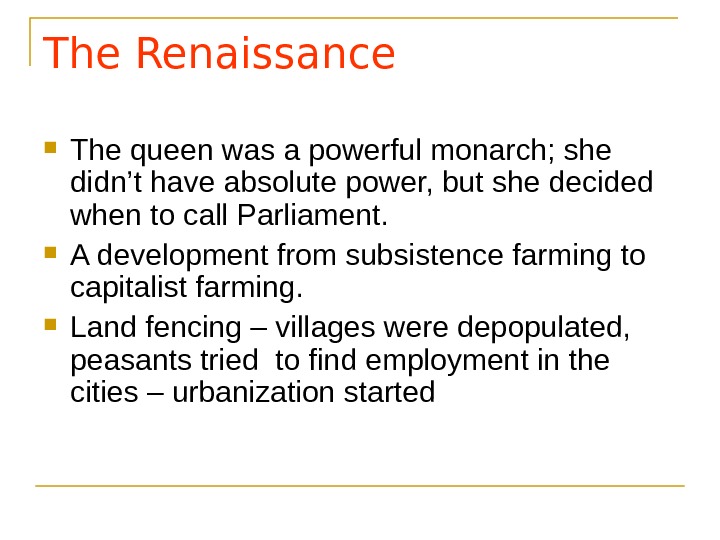
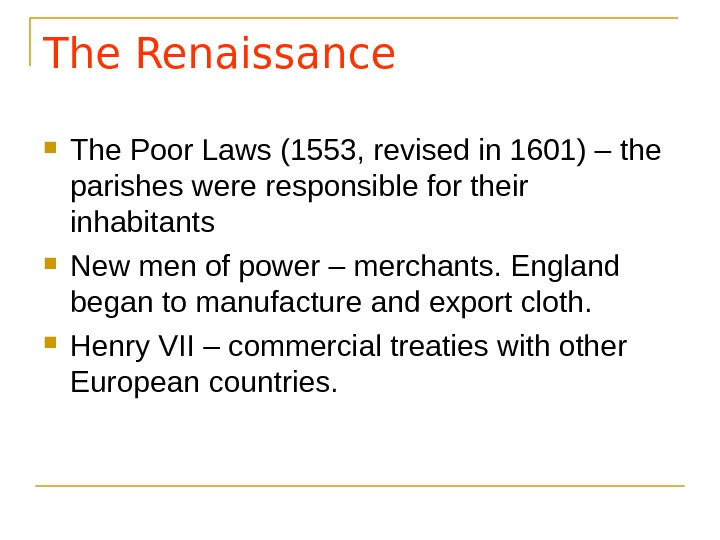
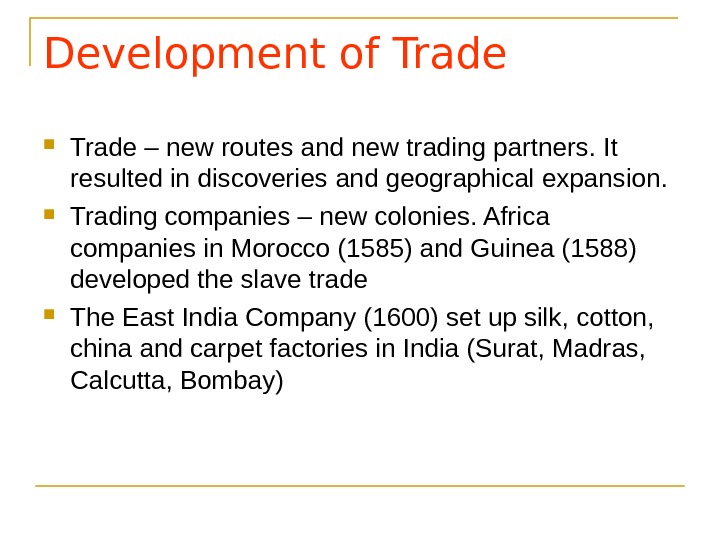
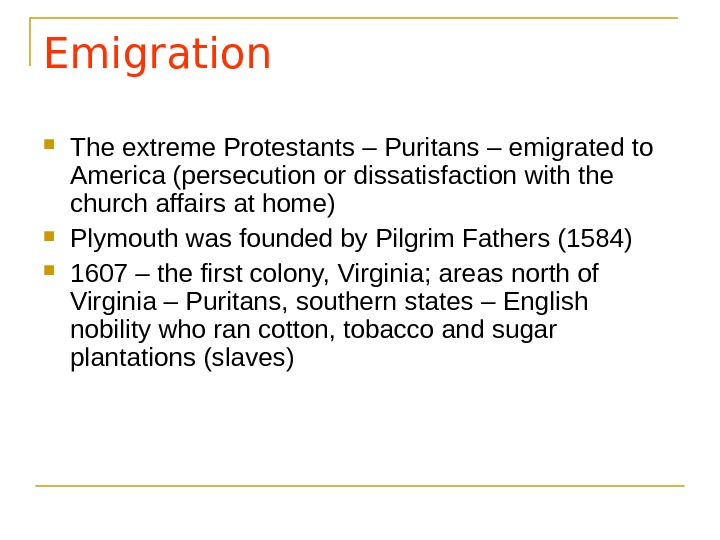
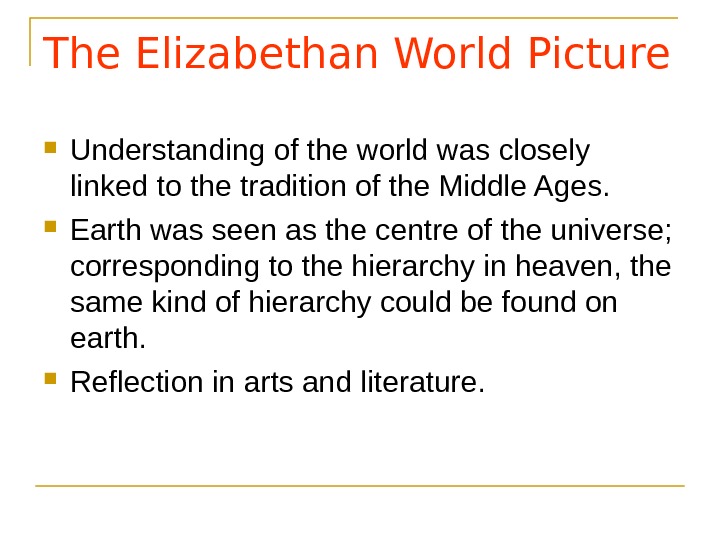
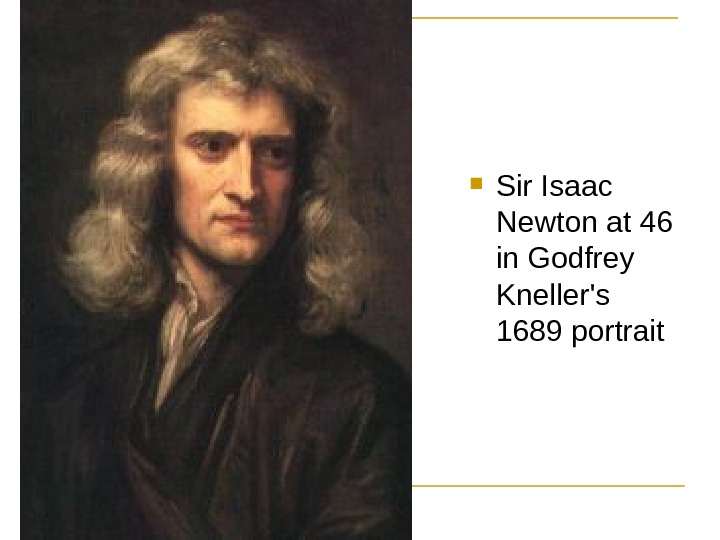
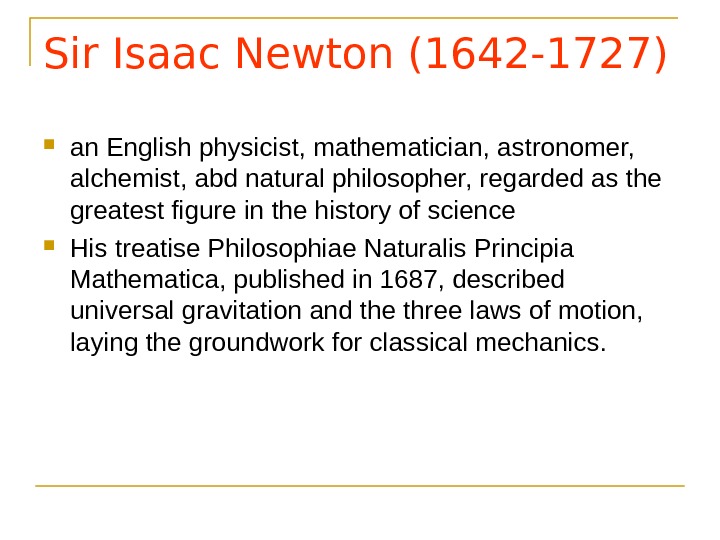
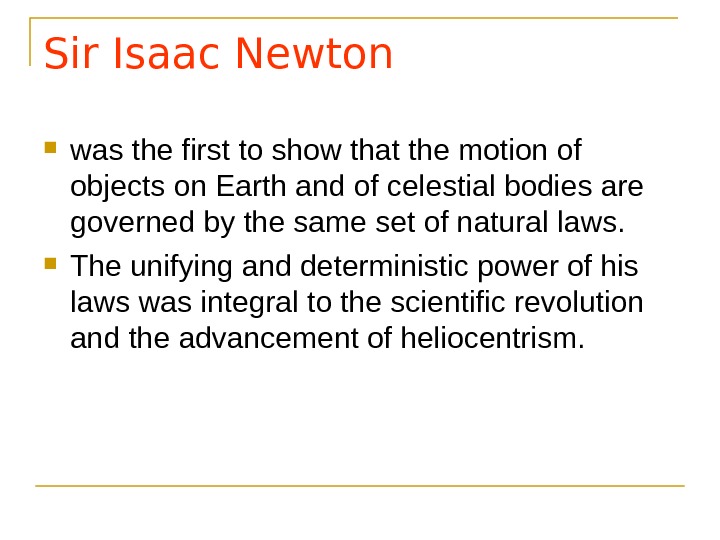
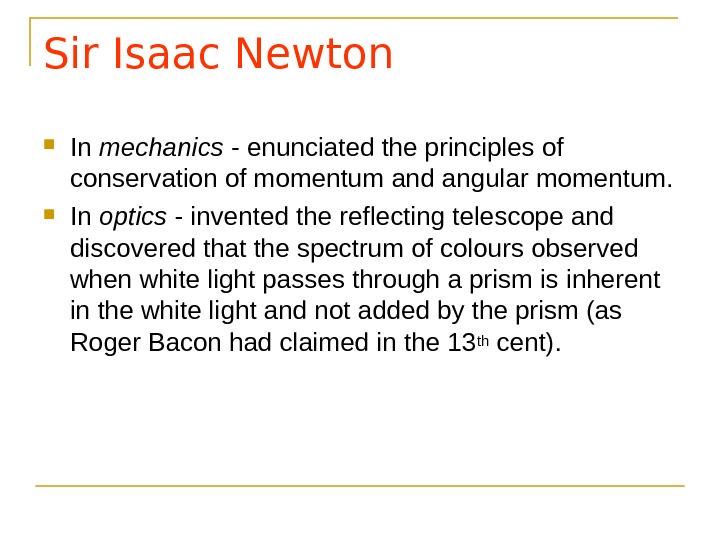
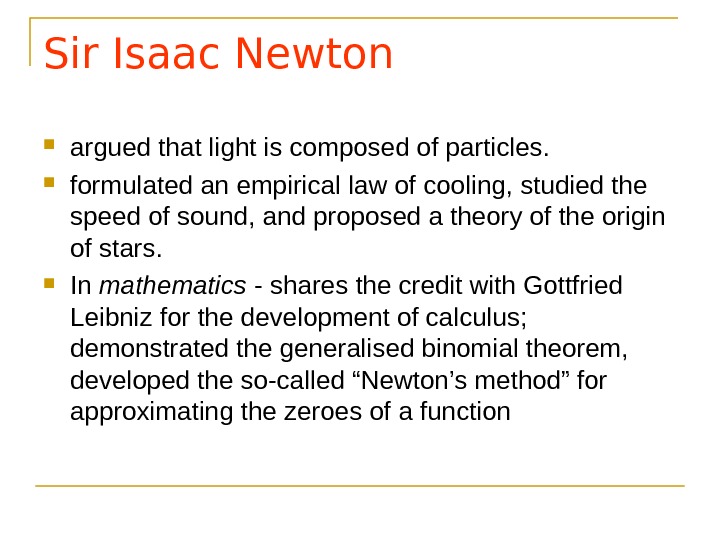
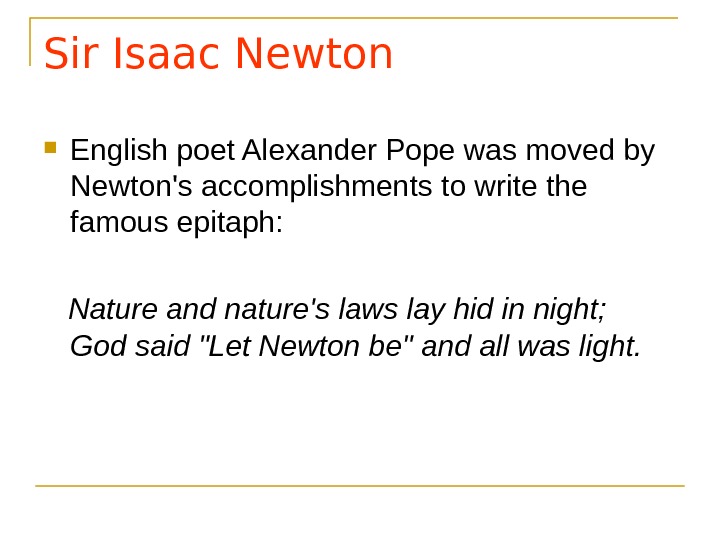
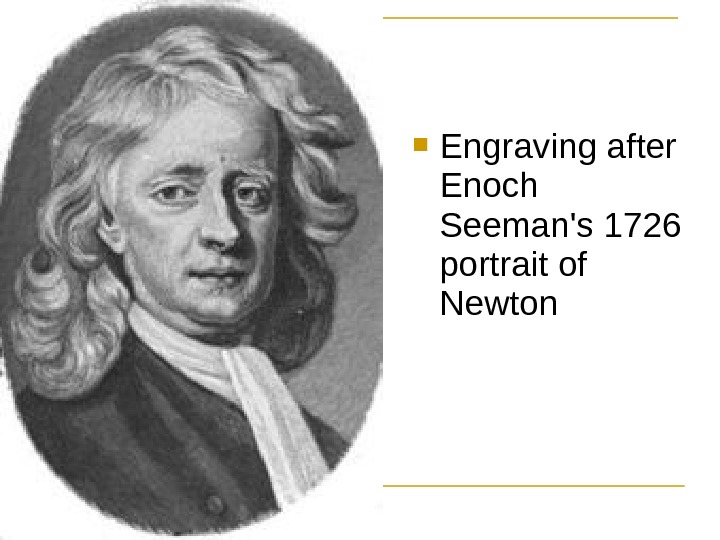
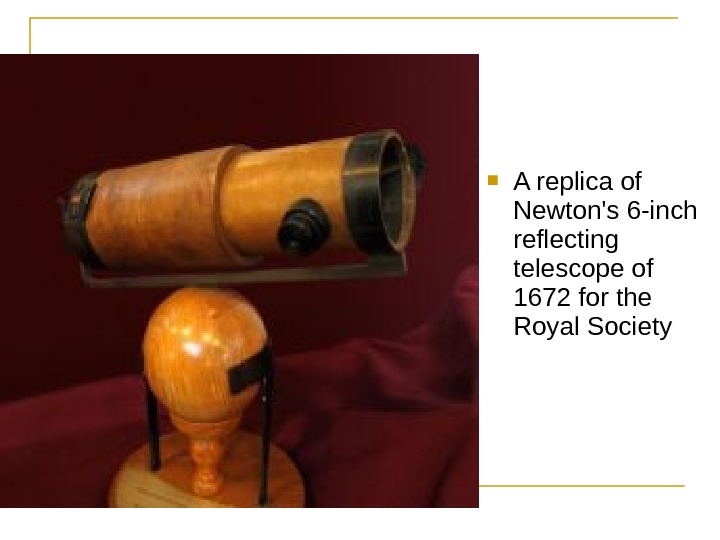
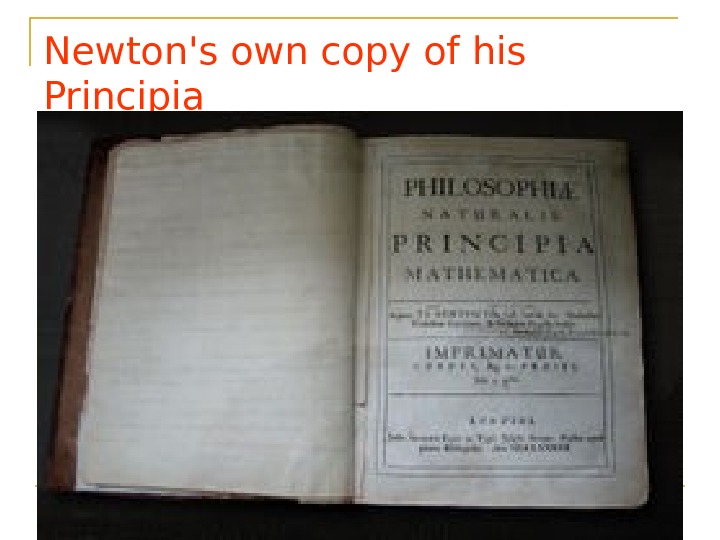
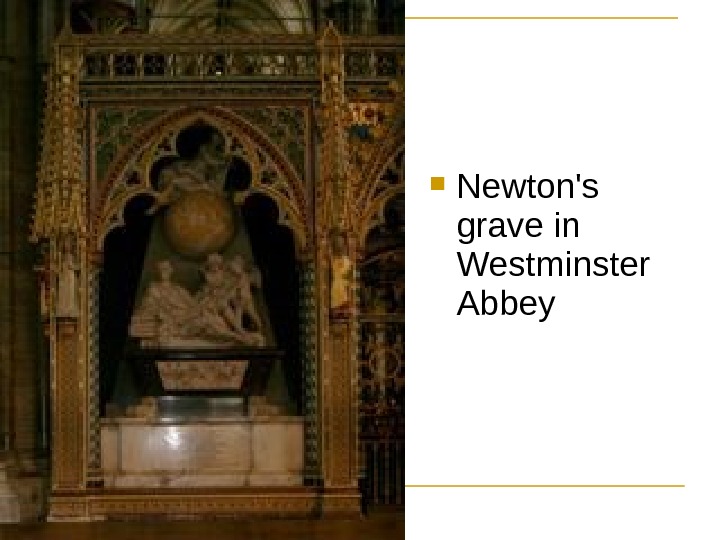
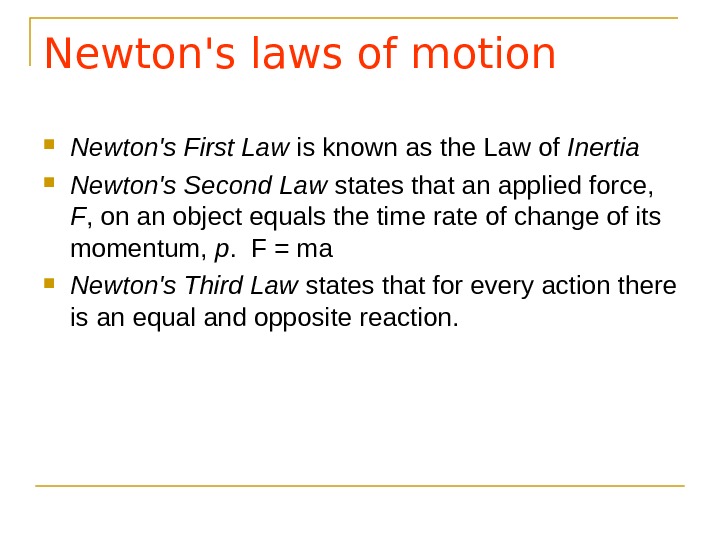
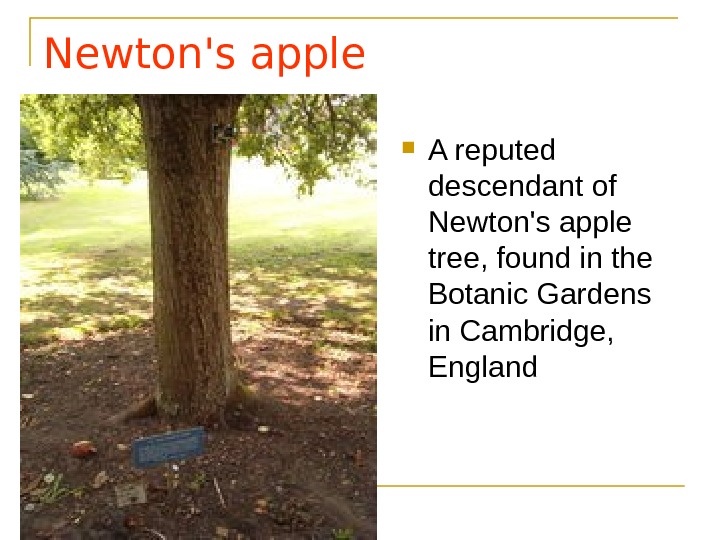
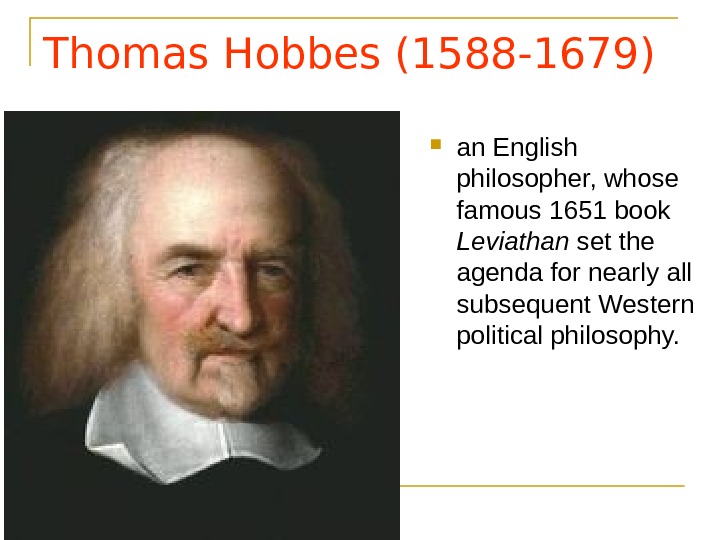
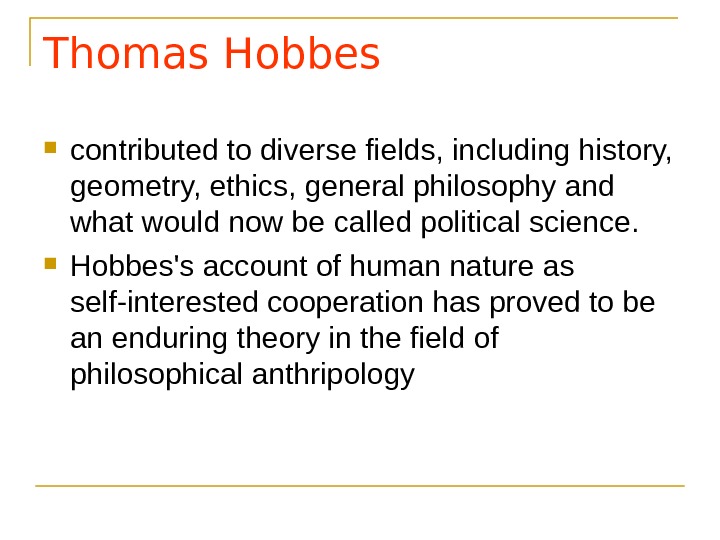
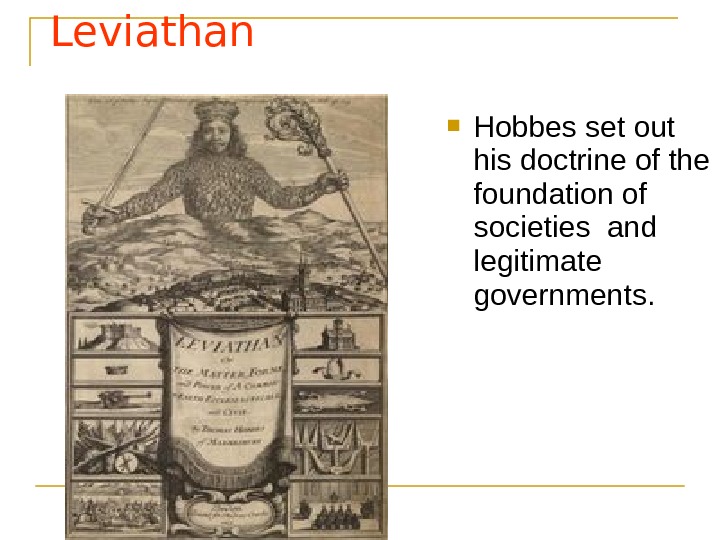
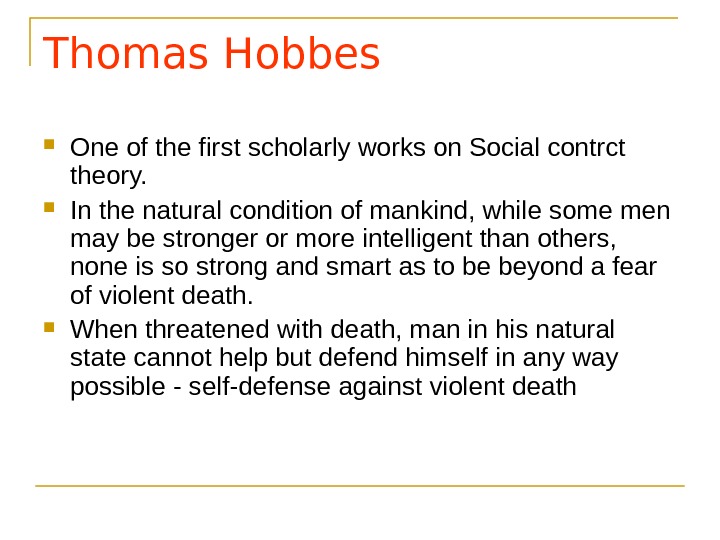
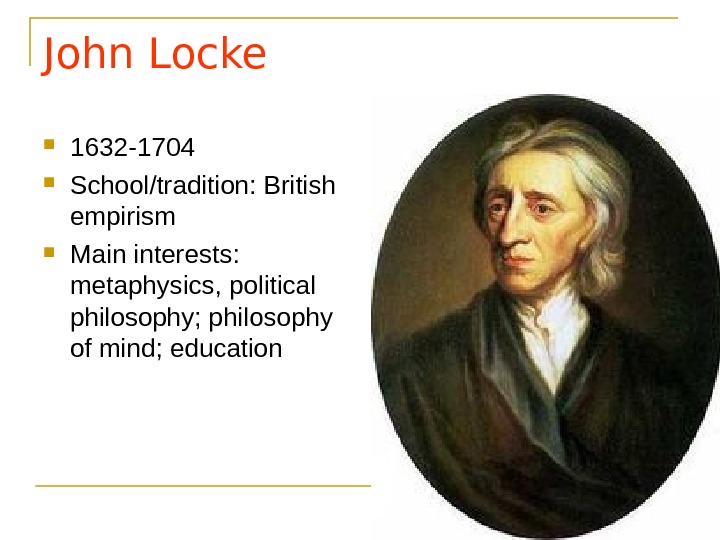
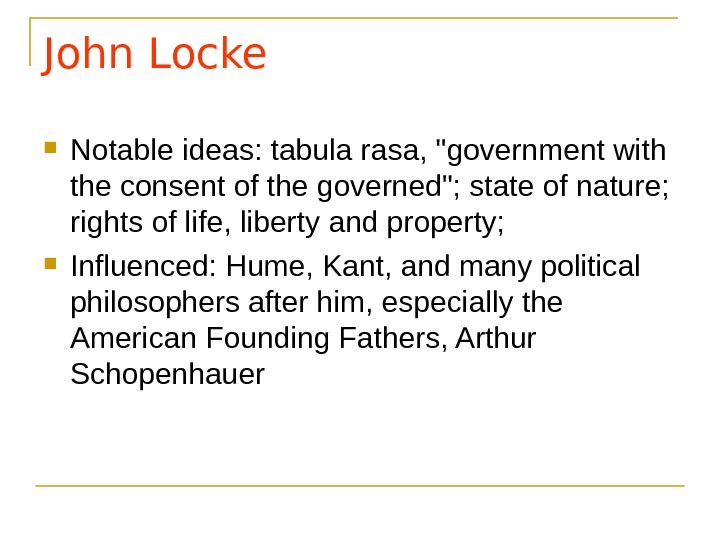
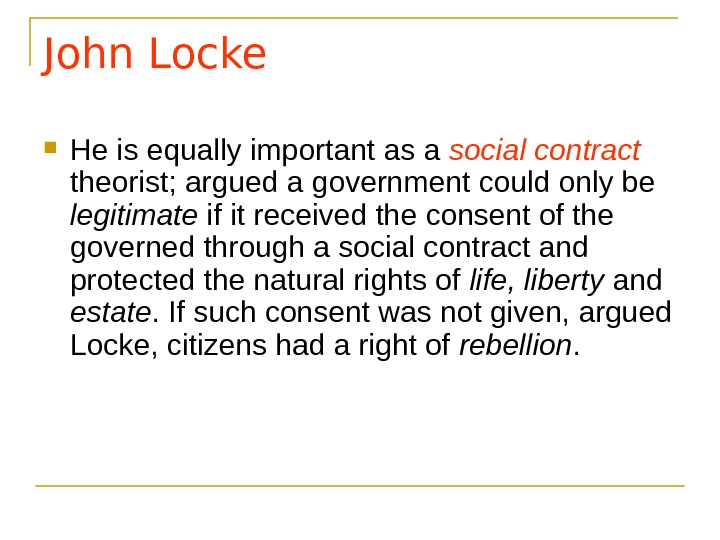
english_renaissance-full.ppt
- Размер: 1022 Кб
- Количество слайдов: 119
Описание презентации English Renaissance Sir Christopher Wren (1632 -1723) по слайдам
 English Renaissance
English Renaissance
 Sir Christopher Wren (1632 -1723) a 17 th century English designer, astronomer, geometrician, and the greatest English architect of his time. designed 53 London churches, including St. Paul’s Cathedral, as well as many notable secular buildings.
Sir Christopher Wren (1632 -1723) a 17 th century English designer, astronomer, geometrician, and the greatest English architect of his time. designed 53 London churches, including St. Paul’s Cathedral, as well as many notable secular buildings.
 Sheldonian Theatre
Sheldonian Theatre
 Hampton Court Palace
Hampton Court Palace
 Hampton Court
Hampton Court

 St Paul’s Cathedral from the south
St Paul’s Cathedral from the south
 Old St. Paul’s
Old St. Paul’s
 Old St Paul’s Cathedral in flames,
Old St Paul’s Cathedral in flames,
 Wren’s Greek Cross design
Wren’s Greek Cross design
 Wren’s warrant design
Wren’s warrant design
 Wren’s cathedral as built
Wren’s cathedral as built
 Wren’s cathedral The clock tower on the west side of the cathedral The cathedral was completed on 20. 1708, Wren’s 76 th birthday (although the first service was held on 02. 1697).
Wren’s cathedral The clock tower on the west side of the cathedral The cathedral was completed on 20. 1708, Wren’s 76 th birthday (although the first service was held on 02. 1697).
 St Paul’s Cathedral The cathedral is built of Portland stone in a late Renaissance style that is England’s sober Baroque. It’s dome rises 108 metres (365 feet) to the cross at its summit, making it a famous London landmark
St Paul’s Cathedral The cathedral is built of Portland stone in a late Renaissance style that is England’s sober Baroque. It’s dome rises 108 metres (365 feet) to the cross at its summit, making it a famous London landmark
 St Paul’s from across the Thames
St Paul’s from across the Thames
 St Paul’s Cathedral The nave has three small chapels in the two adjoining aisles – All Souls and St Dunstan’s in the north aisle and the Chapel of the Order of St Michael and St Georde in the south aisle. The main space of the cathedral is centred under the Dome; it rises 108. 4 metres from the cathedral floor and holds three circular galleries – the internal Whispering Gallery , the external Stone Gallery , and the external Golden Gallery.
St Paul’s Cathedral The nave has three small chapels in the two adjoining aisles – All Souls and St Dunstan’s in the north aisle and the Chapel of the Order of St Michael and St Georde in the south aisle. The main space of the cathedral is centred under the Dome; it rises 108. 4 metres from the cathedral floor and holds three circular galleries – the internal Whispering Gallery , the external Stone Gallery , and the external Golden Gallery.
 St Paul’s Cathedral The organ was first commissioned in 1694 and the current instrument is the third biggest in Britain with 7, 189 pipes and 138 stops The north west tower contains 13 bells, while the south west tower contains 4 bells including Great Paul, which was cast in 1881, and Great Tom (the hour bell), which has been recast twice, after being moved from the old Palace of Westminster
St Paul’s Cathedral The organ was first commissioned in 1694 and the current instrument is the third biggest in Britain with 7, 189 pipes and 138 stops The north west tower contains 13 bells, while the south west tower contains 4 bells including Great Paul, which was cast in 1881, and Great Tom (the hour bell), which has been recast twice, after being moved from the old Palace of Westminster
 Memorials The cathedral has a crypt holding over 200 memorials Christopher Wren was the first person to be buried (1723) «Lector, si monumentum requiris, circumspice» ( Reader, if you seek a monument, look around you ).
Memorials The cathedral has a crypt holding over 200 memorials Christopher Wren was the first person to be buried (1723) «Lector, si monumentum requiris, circumspice» ( Reader, if you seek a monument, look around you ).
 Memorials The Duke of Wellington Admiral Nelson Henry Moore Sir Winston Churchill T. E. Lawrence whise bust Nelson’s sarchofagus
Memorials The Duke of Wellington Admiral Nelson Henry Moore Sir Winston Churchill T. E. Lawrence whise bust Nelson’s sarchofagus
 Memorials Sir Alexander Flemming Sir Arthur Sullivan Florence Nightingale J. M. W. Turner Sir Joshua Reynolds
Memorials Sir Alexander Flemming Sir Arthur Sullivan Florence Nightingale J. M. W. Turner Sir Joshua Reynolds
 Monument to the Great Fire of London 1670 s — Wren received significant secular commissions which manifest both the maturity and the variety of his architecture
Monument to the Great Fire of London 1670 s — Wren received significant secular commissions which manifest both the maturity and the variety of his architecture
 The Greenwich Hospital from the bank of the Thames
The Greenwich Hospital from the bank of the Thames
 The Greenwich Hospital in London was founded in 1694 as the Royal Naval Hospital for Seamen. It is a Royal Charity for the benefit of seafarers and their dependents, with the Secretary of State for Defence acting as the Crown’s sole Trustee.
The Greenwich Hospital in London was founded in 1694 as the Royal Naval Hospital for Seamen. It is a Royal Charity for the benefit of seafarers and their dependents, with the Secretary of State for Defence acting as the Crown’s sole Trustee.
 The Greenwich Hospital The hospital was established as a residential home for injured sailors Was taken over by the Royal Naval College in 1873, and remained a military education establishment until 1998 when passed into the hands of the Greenwich Foundation of the Royal Naval College. The new Foundation has University of Greenwhich and Trinity College of Music.
The Greenwich Hospital The hospital was established as a residential home for injured sailors Was taken over by the Royal Naval College in 1873, and remained a military education establishment until 1998 when passed into the hands of the Greenwich Foundation of the Royal Naval College. The new Foundation has University of Greenwhich and Trinity College of Music.
 The Greenwich Hospital
The Greenwich Hospital
 English Renaissance art the adoption of Protestantism by Henry VIII of England in 1536 and the seizure of property belonging to the Catholic church by the state ( Dissolution of the Monasteries ) — destruction of much of England Wales’ art tradition, which had previously been under the patronage of the church.
English Renaissance art the adoption of Protestantism by Henry VIII of England in 1536 and the seizure of property belonging to the Catholic church by the state ( Dissolution of the Monasteries ) — destruction of much of England Wales’ art tradition, which had previously been under the patronage of the church.
 English Renaissance art Isolation from the trends of catholic Europe, the centre of the Renaissance. Painters from the continent continued to find work in Britain, and brought the new styles with them, especially the Flemish and Italian Renaissance styles.
English Renaissance art Isolation from the trends of catholic Europe, the centre of the Renaissance. Painters from the continent continued to find work in Britain, and brought the new styles with them, especially the Flemish and Italian Renaissance styles.
 Hans Holbein the Younger (1497 -1543) a German artist who painted in the Northern Renaissance style first learned painting from his father Hans Holbein the Elder, was influenced by the Dutch humanist Ersmus Designed stained glass windows and painted portraits. The Reformation made it difficult for Holbein to support himself as an artist in Basel and he set out for London in 1526.
Hans Holbein the Younger (1497 -1543) a German artist who painted in the Northern Renaissance style first learned painting from his father Hans Holbein the Elder, was influenced by the Dutch humanist Ersmus Designed stained glass windows and painted portraits. The Reformation made it difficult for Holbein to support himself as an artist in Basel and he set out for London in 1526.
 Hans Holbein the Younger
Hans Holbein the Younger
 Hans Holbein the Younger many portraits at the court of Henry VIII, designed state robes for the king. designed many of the extravagant monuments and decorations for the coronation of Henry’s second wife, Anne Boleyn, 1533 painted Henry’s third wife, Jane; also painted Jane’s sister, Elizabeth Seymour
Hans Holbein the Younger many portraits at the court of Henry VIII, designed state robes for the king. designed many of the extravagant monuments and decorations for the coronation of Henry’s second wife, Anne Boleyn, 1533 painted Henry’s third wife, Jane; also painted Jane’s sister, Elizabeth Seymour
 Henry VIII Hans Holbein the Younger,
Henry VIII Hans Holbein the Younger,
 Jane and Elizabeth Seymour
Jane and Elizabeth Seymour
 Mary Watton, Lady Guildenford. Hans Holbein the Younger,
Mary Watton, Lady Guildenford. Hans Holbein the Younger,
 Hans Holbein the Younger, Man with a Lute,
Hans Holbein the Younger, Man with a Lute,
 Portrait of Sir Thomas More, by Hans Holbein the Younger,
Portrait of Sir Thomas More, by Hans Holbein the Younger,
 Hans Holbein the Younger Holbein always made a highly detailed portrait of his subject using pencil, often supplemented with ink and coloured chalk; although the drawings were made as referential studies for paintings, they stand as independent works of art. The original drawings emphasized facial detail, but in general did not include the hands. Clothing was only indicated schematically. The original drawings thus had the same scale as the final paintings.
Hans Holbein the Younger Holbein always made a highly detailed portrait of his subject using pencil, often supplemented with ink and coloured chalk; although the drawings were made as referential studies for paintings, they stand as independent works of art. The original drawings emphasized facial detail, but in general did not include the hands. Clothing was only indicated schematically. The original drawings thus had the same scale as the final paintings.
 Marcus Gheeraerts the Elder (1516 -1604) a Flemish engraver, illustrator and painter; most often associated with the English Royal C ourt of the mid-16 th cent; the illustrator of the 1567 edition of Aesop’s Fables. Fled to England in 1568 due to religious persecutions
Marcus Gheeraerts the Elder (1516 -1604) a Flemish engraver, illustrator and painter; most often associated with the English Royal C ourt of the mid-16 th cent; the illustrator of the 1567 edition of Aesop’s Fables. Fled to England in 1568 due to religious persecutions
 Marcus Gheeraerts the Elder There are no identifiable color portraits or paintings done by Gheeraerts as he did never sign them He is most noteworthy as an illustrator and engraver; his sketches and drawings were used for engravings he is well noted for his illustrations of animals and his birdseye view of the town of Brugges
Marcus Gheeraerts the Elder There are no identifiable color portraits or paintings done by Gheeraerts as he did never sign them He is most noteworthy as an illustrator and engraver; his sketches and drawings were used for engravings he is well noted for his illustrations of animals and his birdseye view of the town of Brugges
 Gheeraert’s birdseye view of Brugges, Flanders in
Gheeraert’s birdseye view of Brugges, Flanders in
 Nicholas Hilliard (1547 -1619) the first true English miniature painter born in England He was appointed goldsmith, carver and portrait painter to Elizabeth I and engraved the Great Seal of England in 1586 was in high favour with James I as well as with Elizabeth, receiving from the king a special patent of appointment
Nicholas Hilliard (1547 -1619) the first true English miniature painter born in England He was appointed goldsmith, carver and portrait painter to Elizabeth I and engraved the Great Seal of England in 1586 was in high favour with James I as well as with Elizabeth, receiving from the king a special patent of appointment
 Self-portrait,
Self-portrait,
 Alice Brandon, his wife,
Alice Brandon, his wife,
 Samuel Cooper (1609 -1672) the greatest English painter of portrait miniatures Also was an excellent musician, playing well the lute, and also a good linguist, speaking French with ease.
Samuel Cooper (1609 -1672) the greatest English painter of portrait miniatures Also was an excellent musician, playing well the lute, and also a good linguist, speaking French with ease.
 is known to have painted also the portrait of John Aubrey ,
is known to have painted also the portrait of John Aubrey ,
 Unfinished portrait miniature of Oliver Cromwell, 1657.
Unfinished portrait miniature of Oliver Cromwell, 1657.
 Wenceslas Hollar (1607 -1677) known Wenceslaus Hollar or sometimes Wenzel , was a Bohemian etcher. He was born in Prague, and died in London, being buried at St Margaret’s church, Westminster Studied the art in Germany; was attracted by the famous amateur Thomas, earl of Arundel, then on an embassy to the imperial court in 1637 finally came to England
Wenceslas Hollar (1607 -1677) known Wenceslaus Hollar or sometimes Wenzel , was a Bohemian etcher. He was born in Prague, and died in London, being buried at St Margaret’s church, Westminster Studied the art in Germany; was attracted by the famous amateur Thomas, earl of Arundel, then on an embassy to the imperial court in 1637 finally came to England
 Wenceslas Hollar
Wenceslas Hollar
 Godfrey Kneller Sir Godfrey Kneller, 1 st Baronet (1646 -1723) -the leading portrait painter in ( late 17 th and early 18 th cent), court painter to British monarchs from Charles II to George I. major works: The Chinese Convert (1687); a series of ten reigning European monarchs, including King Louis XIV of Frnace; over 40 “Kit-cat portraits» of members of the Kit-Cat Club; and ten «beauties» of the court of William III
Godfrey Kneller Sir Godfrey Kneller, 1 st Baronet (1646 -1723) -the leading portrait painter in ( late 17 th and early 18 th cent), court painter to British monarchs from Charles II to George I. major works: The Chinese Convert (1687); a series of ten reigning European monarchs, including King Louis XIV of Frnace; over 40 “Kit-cat portraits» of members of the Kit-Cat Club; and ten «beauties» of the court of William III
 Godfrey Kneller Gottfried Kniller in L übeck, Germany; studied in Leiden, but became a pupil of Ferdinand Bol and Rembrandt in Amsterdam. worked in Rome and Venice in the early 1670 s, painting historical subjects and portraits, and later moved to Hamburg. came to England in 1674, at the invitation of the Duke of Monmouth, accompanied by his brother, John Zacharias Kneller, who was an ornamental painter.
Godfrey Kneller Gottfried Kniller in L übeck, Germany; studied in Leiden, but became a pupil of Ferdinand Bol and Rembrandt in Amsterdam. worked in Rome and Venice in the early 1670 s, painting historical subjects and portraits, and later moved to Hamburg. came to England in 1674, at the invitation of the Duke of Monmouth, accompanied by his brother, John Zacharias Kneller, who was an ornamental painter.
 Godfrey Kneller founded a studio which churned out portraits on an almost industrial scale, relyed on a brief sketch of the face with details added to a formulaic model, aided by the fashion for gentlemen to wear full wigs. His portraits set a pattern that was followed until William Hogarth and Joshua Reynolds. Nevertheless, he established himself as a leading portrait artist in England.
Godfrey Kneller founded a studio which churned out portraits on an almost industrial scale, relyed on a brief sketch of the face with details added to a formulaic model, aided by the fashion for gentlemen to wear full wigs. His portraits set a pattern that was followed until William Hogarth and Joshua Reynolds. Nevertheless, he established himself as a leading portrait artist in England.
 The Kit-Cat Club was an early 18 th century club in London with strong political and literary associations, committed to Whig objectives. It was founded in 1699 by the book seller Jacob Tonson and met at the Trumpet pub in London, and at Water Oakley in the Berkshire countryside. it may have been a secret society active in furthering the Glorious Revolution of
The Kit-Cat Club was an early 18 th century club in London with strong political and literary associations, committed to Whig objectives. It was founded in 1699 by the book seller Jacob Tonson and met at the Trumpet pub in London, and at Water Oakley in the Berkshire countryside. it may have been a secret society active in furthering the Glorious Revolution of
 The Kit-Cat Club is known today as an early 18 th century social gathering-point in London for culturally andpolitically prominent Whigs Kit (= Christopher) Cat (= Catling), the keeper of the pie-house in Shire Lane, by Temple Bar, where the club originally met
The Kit-Cat Club is known today as an early 18 th century social gathering-point in London for culturally andpolitically prominent Whigs Kit (= Christopher) Cat (= Catling), the keeper of the pie-house in Shire Lane, by Temple Bar, where the club originally met
 The Kit-Cat Club The Kit-Kat series of chocolate bars is believed to be named after the Kit-Cat Club. The musical Cabaret takes place at a fictional Berlin nightclub also called the Kit-Kat Klub. The Kit-Cat club name was revived in London in the 1980 s and is now used by an exclusive women’s club which meets monthly at the Lanesborough Hotel A Kit-Cat portrait – a middle-sized portrait
The Kit-Cat Club The Kit-Kat series of chocolate bars is believed to be named after the Kit-Cat Club. The musical Cabaret takes place at a fictional Berlin nightclub also called the Kit-Kat Klub. The Kit-Cat club name was revived in London in the 1980 s and is now used by an exclusive women’s club which meets monthly at the Lanesborough Hotel A Kit-Cat portrait – a middle-sized portrait
 Joseph Addison, the “Kit-cat portrait”, 1703– 1712, by Godfrey Kneller
Joseph Addison, the “Kit-cat portrait”, 1703– 1712, by Godfrey Kneller
 William Congreve
William Congreve
 Sir John Vanbrugh in Godfrey Kneller’s Kit-cat portrait, considered one of Kneller’s finest portraits.
Sir John Vanbrugh in Godfrey Kneller’s Kit-cat portrait, considered one of Kneller’s finest portraits.
 The Rt Hon. Sir Robert Walpole
The Rt Hon. Sir Robert Walpole
 John Churchill, 1 st Duke of Marlboroughin his Garter robes
John Churchill, 1 st Duke of Marlboroughin his Garter robes
 James Thornhill (1675 -1734) an English painter of historical subjects, in the Italian baroque tradition successfully worked for the upper class as a history painter court painter decorated palace interiors with large-scale compositions
James Thornhill (1675 -1734) an English painter of historical subjects, in the Italian baroque tradition successfully worked for the upper class as a history painter court painter decorated palace interiors with large-scale compositions
 James Thornhill (1675 -1734) The figures of wall paintings are commonly shown in idealized and rhetorical postures: the allegorical wall and ceiling decorations of the Painted Hall at Greenwich Hospital (1707 -27) depicting the Protestant succession of English monarchs from William and Mary to George I; the eight scenes from the Life of St. Paul in the cupola of St. Paul’s Cathedral (1716 -19); etc.
James Thornhill (1675 -1734) The figures of wall paintings are commonly shown in idealized and rhetorical postures: the allegorical wall and ceiling decorations of the Painted Hall at Greenwich Hospital (1707 -27) depicting the Protestant succession of English monarchs from William and Mary to George I; the eight scenes from the Life of St. Paul in the cupola of St. Paul’s Cathedral (1716 -19); etc.
 James Thornhill (1675 -1734) 1711 — Thornhill was one of the 12 original directors of Sir Godfrey Kneller’s academy at Great Queen Street. 1716 — succeeded Kneller as Governor there and held the post until 1720. Then established his own private drawing school at Covent Garden, but this was soon closed.
James Thornhill (1675 -1734) 1711 — Thornhill was one of the 12 original directors of Sir Godfrey Kneller’s academy at Great Queen Street. 1716 — succeeded Kneller as Governor there and held the post until 1720. Then established his own private drawing school at Covent Garden, but this was soon closed.
 Potrait of Sir Isaac Newton in old age by James Thornhill, 1709 -12.
Potrait of Sir Isaac Newton in old age by James Thornhill, 1709 -12.
 Age of Enlightenment refers to either the 18 th cnt in European philosophy, or the longer period including the seventeenth century and the Age of Reason. the historical intellectual movement The Enlightenment advocated Reason as a means to establishing an authoritative system of aesthetics, ethics, government and logic which would allow human beings to obtain objective truth about the universe.
Age of Enlightenment refers to either the 18 th cnt in European philosophy, or the longer period including the seventeenth century and the Age of Reason. the historical intellectual movement The Enlightenment advocated Reason as a means to establishing an authoritative system of aesthetics, ethics, government and logic which would allow human beings to obtain objective truth about the universe.
 Age of Enlightenment thinkers argued that the systematic thinking could apply to all forms of human activity The intellectual leaders — would lead the world into progress from a long period of doubtful tradition, irrationality, superstition, and tyranny, which they imputed to the Dark Ages.
Age of Enlightenment thinkers argued that the systematic thinking could apply to all forms of human activity The intellectual leaders — would lead the world into progress from a long period of doubtful tradition, irrationality, superstition, and tyranny, which they imputed to the Dark Ages.
 Age of Enlightenment Revolutions — the rise of classical liberalism and capitalism. matched with the high baroque and classical eras in music, and the neo-classical period in the arts; receives contemporary attention as being one of the central models for many movements in the modern period.
Age of Enlightenment Revolutions — the rise of classical liberalism and capitalism. matched with the high baroque and classical eras in music, and the neo-classical period in the arts; receives contemporary attention as being one of the central models for many movements in the modern period.
 Creation of a Middle Class After Elizabeth’s death (1603) England changed from aristocratic society to a society dominated by the middle class. Glorious Revolution 1688 – the victory of Parliament New culture and world view – individual man became the centre of the world; optimistic belief in human reason and progress
Creation of a Middle Class After Elizabeth’s death (1603) England changed from aristocratic society to a society dominated by the middle class. Glorious Revolution 1688 – the victory of Parliament New culture and world view – individual man became the centre of the world; optimistic belief in human reason and progress
 Political Life 1642 -1648 – The English Civil War 1649 – execution of Charles I; republic under the leadership of Oliver Cromwell The Restoration (1660) brought back the monarchy as a reaction against Puritan and military control – Charles II. 1688 – a Dutch prince, William of Orange, was invited to become King of England
Political Life 1642 -1648 – The English Civil War 1649 – execution of Charles I; republic under the leadership of Oliver Cromwell The Restoration (1660) brought back the monarchy as a reaction against Puritan and military control – Charles II. 1688 – a Dutch prince, William of Orange, was invited to become King of England
 Anthony van Dyck, «Charles I, King of England, from Three Angles», commonly known as the «Triple Portrait“ (1636). It was created in order that Bernini, could create a marble bust of Charles.
Anthony van Dyck, «Charles I, King of England, from Three Angles», commonly known as the «Triple Portrait“ (1636). It was created in order that Bernini, could create a marble bust of Charles.
 German print depicts Charles I’s decapitation
German print depicts Charles I’s decapitation
 An unfinished miniature portrait of Oliver Cromwell by Samuel Cooper, 1657.
An unfinished miniature portrait of Oliver Cromwell by Samuel Cooper, 1657.
 Statue of Oliver Cromwell outside the Palace of Westminster, London
Statue of Oliver Cromwell outside the Palace of Westminster, London
 The Glorious Revolution 1689 – William III signed the Bill of Rights. Reduced royal power and civil and political rights (e. g. freedom of speech) to the people Parliament – power to make laws. New dynamic world picture with an individual man at the centre. John Locke (1632 -1704) – ideas about tolerance, freedom and the value of human reason.
The Glorious Revolution 1689 – William III signed the Bill of Rights. Reduced royal power and civil and political rights (e. g. freedom of speech) to the people Parliament – power to make laws. New dynamic world picture with an individual man at the centre. John Locke (1632 -1704) – ideas about tolerance, freedom and the value of human reason.
 17 th-century philosophy the start of modern philosophy, and the shaking off of the medieval approach, especially scholasticism the «Age of Reason» is considered to succeed the Renaissance and precede the Age of Enlightenment.
17 th-century philosophy the start of modern philosophy, and the shaking off of the medieval approach, especially scholasticism the «Age of Reason» is considered to succeed the Renaissance and precede the Age of Enlightenment.
 17 th-century philosophy The period in Europe — the great system-builders — philosophers who present unified systems of epistemology, metaphysics, logic, and ethics, and often politics and the physical sciences too I. Kant classified his predecessors into two schools: the Rationalists and the Empiricists Early Modern Philosophy (17 th -18 th cent) is often characterised in terms of a supposed conflict between these schools
17 th-century philosophy The period in Europe — the great system-builders — philosophers who present unified systems of epistemology, metaphysics, logic, and ethics, and often politics and the physical sciences too I. Kant classified his predecessors into two schools: the Rationalists and the Empiricists Early Modern Philosophy (17 th -18 th cent) is often characterised in terms of a supposed conflict between these schools
 17 th-century philosophy The three main Rationalists are Descartes, Spinoza, and Leibniz. Building upon their English predecessors Fr. Bacon and Th. Hobbes, the three main Empiricists were John Locke, George Berkeley and David Hume.
17 th-century philosophy The three main Rationalists are Descartes, Spinoza, and Leibniz. Building upon their English predecessors Fr. Bacon and Th. Hobbes, the three main Empiricists were John Locke, George Berkeley and David Hume.
 George Berkeley an influential Irish philosopher whose philosophical achievement is the advancement of subjective idealism, summed up in his dictum, «Esse est percipi» (“To be is to be percieved»).
George Berkeley an influential Irish philosopher whose philosophical achievement is the advancement of subjective idealism, summed up in his dictum, «Esse est percipi» (“To be is to be percieved»).
 George Berkeley theorized that individuals cannot know if an object is , individuals can only know if an object is perceived by a mind. individuals cannot think or talk about an object’s being but rather think or talk about an object’s being perceived by someone all that individuals know about an object is their perception of it.
George Berkeley theorized that individuals cannot know if an object is , individuals can only know if an object is perceived by a mind. individuals cannot think or talk about an object’s being but rather think or talk about an object’s being perceived by someone all that individuals know about an object is their perception of it.
 Metaphysical poets a loose group of British lyric poets of the 17 th century, who shared an interest in metaphysical concerns and a common way of investigating them Their rigorous verse appeals to the reader’s intellect rather than emotions. Their style was characterised by wit , subtle argumentations and the «metaphysical conceits «, an unusual simile or metaphor
Metaphysical poets a loose group of British lyric poets of the 17 th century, who shared an interest in metaphysical concerns and a common way of investigating them Their rigorous verse appeals to the reader’s intellect rather than emotions. Their style was characterised by wit , subtle argumentations and the «metaphysical conceits «, an unusual simile or metaphor
 Metaphysical poets Their writings reflected the disturbances of the period Metaphysical poetry means showing clever tricks of style and unlikely comparisons. Use of symbols, pictures and metaphors are taken from all parts of existence and dramatically and surprisingly mixed Poems are short and concentrated, built up around one idea or line of argument.
Metaphysical poets Their writings reflected the disturbances of the period Metaphysical poetry means showing clever tricks of style and unlikely comparisons. Use of symbols, pictures and metaphors are taken from all parts of existence and dramatically and surprisingly mixed Poems are short and concentrated, built up around one idea or line of argument.
 Metaphysical poets Some metaphysical poets, (John Donne) , were influenced by neo-Platonism. One of the primary Platonic concepts was the idea that the perfection of beauty in the beloved acted as a remembrance of perfect beauty in the eternal realm. The first mention of «metaphysical poets» comes in Samuel Johnson’s The Lives of the Poets (1744).
Metaphysical poets Some metaphysical poets, (John Donne) , were influenced by neo-Platonism. One of the primary Platonic concepts was the idea that the perfection of beauty in the beloved acted as a remembrance of perfect beauty in the eternal realm. The first mention of «metaphysical poets» comes in Samuel Johnson’s The Lives of the Poets (1744).
 John Donne (1572 -1631) was a Jacobean poet and preacher, the representative of the metaphysical poets of the period Sonnets, love poetry, religious poems, Latin translations, epigrams, elegies, songs, satirical verses and sermons.
John Donne (1572 -1631) was a Jacobean poet and preacher, the representative of the metaphysical poets of the period Sonnets, love poetry, religious poems, Latin translations, epigrams, elegies, songs, satirical verses and sermons.
 John Donne His works were notable for their realistic and sensual style His poetry is noted for the vibrancy of language and immediacy of metaphor many of his poems were written for wealthy friends or patrons ( Anniversaries , An Anatomy of the World (1611) and Of the Progress of the Soul , (1612) )
John Donne His works were notable for their realistic and sensual style His poetry is noted for the vibrancy of language and immediacy of metaphor many of his poems were written for wealthy friends or patrons ( Anniversaries , An Anatomy of the World (1611) and Of the Progress of the Soul , (1612) )
 John Donne 1610 and 1611 — two anti-Catholic polemics, Pseudo-Martyr and Ignatius his Conclave. After a long period of financial uncertainty and difficulty, Donne finally was ordained into the Church of England in 1615. 1621 — Donne was made Dean of St Paul’s, a leading position in the Church of England
John Donne 1610 and 1611 — two anti-Catholic polemics, Pseudo-Martyr and Ignatius his Conclave. After a long period of financial uncertainty and difficulty, Donne finally was ordained into the Church of England in 1615. 1621 — Donne was made Dean of St Paul’s, a leading position in the Church of England
 John Milton (1608 -1674) was originally destined for a ministerial career, but independent spirit led him to give this up Milton is considered to be among the most learned of all English poets
John Milton (1608 -1674) was originally destined for a ministerial career, but independent spirit led him to give this up Milton is considered to be among the most learned of all English poets
 John Milton Unsuccessful experience of his own married life pushed him into writing a series of pamphlets arguing for the legality and morality of divorce ( The Doctrine and Discipline of Divorce), in which he attacked the English marriage law
John Milton Unsuccessful experience of his own married life pushed him into writing a series of pamphlets arguing for the legality and morality of divorce ( The Doctrine and Discipline of Divorce), in which he attacked the English marriage law
 John Milton wrote propaganda for the English Republic in the early 1650 s, in attempts to justify the execution of Charles I; got caught and arrested in October 1659 1667 — published Paradise Lost , the epic brought him universal fame (he sold the publishing rights for £ 10), to be followed by Paradise Regained , together with Samson Agonistes , a drama on the Greek model, in 1671.
John Milton wrote propaganda for the English Republic in the early 1650 s, in attempts to justify the execution of Charles I; got caught and arrested in October 1659 1667 — published Paradise Lost , the epic brought him universal fame (he sold the publishing rights for £ 10), to be followed by Paradise Regained , together with Samson Agonistes , a drama on the Greek model, in 1671.
 Paradise Lost the poem depicts the creation of the universe, earth, and humanity; conveys the origin of sin, death, and evil; imagines events in Hell, the Kingdom of Heaven, the garden of Eden, and the sacred history of Israel; engages with political ideas of tyranny, liberty and justice; and defends theological positions on predestination, free will, and salvation.
Paradise Lost the poem depicts the creation of the universe, earth, and humanity; conveys the origin of sin, death, and evil; imagines events in Hell, the Kingdom of Heaven, the garden of Eden, and the sacred history of Israel; engages with political ideas of tyranny, liberty and justice; and defends theological positions on predestination, free will, and salvation.
 Milton’s influence Keats felt that Paradise Lost was a «beautiful and grand curiosity» Mary Shelley’s work Frankenstein draws heavily on Paradise Lost : the relationship between the Creature and Dr. Frankenstein is often seen as a metaphor for the relationship between God and Man in Paradise Lost George Eliot and Thomas Hardy were particularly inspired by Milton’s poetry and biography
Milton’s influence Keats felt that Paradise Lost was a «beautiful and grand curiosity» Mary Shelley’s work Frankenstein draws heavily on Paradise Lost : the relationship between the Creature and Dr. Frankenstein is often seen as a metaphor for the relationship between God and Man in Paradise Lost George Eliot and Thomas Hardy were particularly inspired by Milton’s poetry and biography
 Milton’s influence Milton coined many familiar modern words : dreary , acclaim , rebuff , self-esteem , unaided , impassive , enslaved , jubilant , solaced , and satanic In terms of politics, Milton’s Areopagitica and republican writings were consulted during the drafting of the Constitution of the USA.
Milton’s influence Milton coined many familiar modern words : dreary , acclaim , rebuff , self-esteem , unaided , impassive , enslaved , jubilant , solaced , and satanic In terms of politics, Milton’s Areopagitica and republican writings were consulted during the drafting of the Constitution of the USA.
 Classicism Contrast to metaphysical poets; influence of old aristocracy with its intellectual and elegantly witty taste Neo-classicist poets thought that the aim of poetry was to give new and perfect expression and form to old truths. Alexander Pope (1688 -1744) – the need to follow the classical rules of poetry (Roman poets).
Classicism Contrast to metaphysical poets; influence of old aristocracy with its intellectual and elegantly witty taste Neo-classicist poets thought that the aim of poetry was to give new and perfect expression and form to old truths. Alexander Pope (1688 -1744) – the need to follow the classical rules of poetry (Roman poets).
 the greatest English poet of the early 18 th cent, best known for his satirical verse and for his translation of Homer. Pope was a master of the heroic couplet.
the greatest English poet of the early 18 th cent, best known for his satirical verse and for his translation of Homer. Pope was a master of the heroic couplet.
 The Rise of Novel Middle class – sales of books big enough to earn writers a living Middle class – ever-growing interest in literature; market for writers Middle-class values; psychological description of individuals and realistic description of places New genre – the novel
The Rise of Novel Middle class – sales of books big enough to earn writers a living Middle class – ever-growing interest in literature; market for writers Middle-class values; psychological description of individuals and realistic description of places New genre – the novel
 The Rise of Novel Daniel Defoe , The Life and Strange Surprising Adventures of Robinson Crusoe (1719) Robinson – an optimistic symbol of the new middle-class man, who triumphs over nature and creates prosperity, security, law and order out of nothing. Practical middle-class virtues The manifesto of a young nation
The Rise of Novel Daniel Defoe , The Life and Strange Surprising Adventures of Robinson Crusoe (1719) Robinson – an optimistic symbol of the new middle-class man, who triumphs over nature and creates prosperity, security, law and order out of nothing. Practical middle-class virtues The manifesto of a young nation
 The Rise of Novel Jonathan Swift (1667 -1745) — an Anglo-Irish priest, satirist, essayist, political pamphleteer, and poet, famous for works like Gulliver’s Travels, A Modest Proposal , A Journal to Stella
The Rise of Novel Jonathan Swift (1667 -1745) — an Anglo-Irish priest, satirist, essayist, political pamphleteer, and poet, famous for works like Gulliver’s Travels, A Modest Proposal , A Journal to Stella
 The Rise of Novel Henry Fielding , The History of Tom Jones, a Foundling (1744) Tom Jones – a panoramic commentary on England in 1745 as well as the story of Tom Jones’ life. Carefully planned plot, un-idealized hero, descriptions given by the narrator
The Rise of Novel Henry Fielding , The History of Tom Jones, a Foundling (1744) Tom Jones – a panoramic commentary on England in 1745 as well as the story of Tom Jones’ life. Carefully planned plot, un-idealized hero, descriptions given by the narrator
 The Renaissance The queen was a powerful monarch; she didn’t have absolute power, but she decided when to call Parliament. A development from subsistence farming to capitalist farming. Land fencing – villages were depopulated, peasants tried to find employment in the cities – urbanization started
The Renaissance The queen was a powerful monarch; she didn’t have absolute power, but she decided when to call Parliament. A development from subsistence farming to capitalist farming. Land fencing – villages were depopulated, peasants tried to find employment in the cities – urbanization started
 The Renaissance The Poor Laws (1553, revised in 1601) – the parishes were responsible for their inhabitants New men of power – merchants. England began to manufacture and export cloth. Henry VII – commercial treaties with other European countries.
The Renaissance The Poor Laws (1553, revised in 1601) – the parishes were responsible for their inhabitants New men of power – merchants. England began to manufacture and export cloth. Henry VII – commercial treaties with other European countries.
 Development of Trade – new routes and new trading partners. It resulted in discoveries and geographical expansion. Trading companies – new colonies. Africa companies in Morocco (1585) and Guinea (1588) developed the slave trade The East India Company (1600) set up silk, cotton, china and carpet factories in India (Surat, Madras, Calcutta, Bombay)
Development of Trade – new routes and new trading partners. It resulted in discoveries and geographical expansion. Trading companies – new colonies. Africa companies in Morocco (1585) and Guinea (1588) developed the slave trade The East India Company (1600) set up silk, cotton, china and carpet factories in India (Surat, Madras, Calcutta, Bombay)
 Emigration The extreme Protestants – Puritans – emigrated to America (persecution or dissatisfaction with the church affairs at home) Plymouth was founded by Pilgrim Fathers (1584) 1607 – the first colony, Virginia; areas north of Virginia – Puritans, southern states – English nobility who ran cotton, tobacco and sugar plantations (slaves)
Emigration The extreme Protestants – Puritans – emigrated to America (persecution or dissatisfaction with the church affairs at home) Plymouth was founded by Pilgrim Fathers (1584) 1607 – the first colony, Virginia; areas north of Virginia – Puritans, southern states – English nobility who ran cotton, tobacco and sugar plantations (slaves)
 The Elizabethan World Picture Understanding of the world was closely linked to the tradition of the Middle Ages. Earth was seen as the centre of the universe; corresponding to the hierarchy in heaven, the same kind of hierarchy could be found on earth. Reflection in arts and literature.
The Elizabethan World Picture Understanding of the world was closely linked to the tradition of the Middle Ages. Earth was seen as the centre of the universe; corresponding to the hierarchy in heaven, the same kind of hierarchy could be found on earth. Reflection in arts and literature.
 Sir Isaac Newton at 46 in Godfrey Kneller’s 1689 portrait
Sir Isaac Newton at 46 in Godfrey Kneller’s 1689 portrait
 Sir Isaac Newton (1642 -1727) an English physicist, mathematician, astronomer, alchemist, abd natural philosopher, regarded as the greatest figure in the history of science His treatise Philosophiae Naturalis Principia Mathematica, published in 1687, described universal gravitation and the three laws of motion, laying the groundwork for classical mechanics.
Sir Isaac Newton (1642 -1727) an English physicist, mathematician, astronomer, alchemist, abd natural philosopher, regarded as the greatest figure in the history of science His treatise Philosophiae Naturalis Principia Mathematica, published in 1687, described universal gravitation and the three laws of motion, laying the groundwork for classical mechanics.
 Sir Isaac Newton was the first to show that the motion of objects on Earth and of celestial bodies are governed by the same set of natural laws. The unifying and deterministic power of his laws was integral to the scientific revolution and the advancement of heliocentrism.
Sir Isaac Newton was the first to show that the motion of objects on Earth and of celestial bodies are governed by the same set of natural laws. The unifying and deterministic power of his laws was integral to the scientific revolution and the advancement of heliocentrism.
 Sir Isaac Newton In mechanics — enunciated the principles of conservation of momentum and angular momentum. In optics — invented the reflecting telescope and discovered that the spectrum of colours observed when white light passes through a prism is inherent in the white light and not added by the prism (as Roger Bacon had claimed in the 13 th cent).
Sir Isaac Newton In mechanics — enunciated the principles of conservation of momentum and angular momentum. In optics — invented the reflecting telescope and discovered that the spectrum of colours observed when white light passes through a prism is inherent in the white light and not added by the prism (as Roger Bacon had claimed in the 13 th cent).
 Sir Isaac Newton argued that light is composed of particles. formulated an empirical law of cooling, studied the speed of sound, and proposed a theory of the origin of stars. In mathematics — shares the credit with Gottfried Leibniz for the development of calculus; demonstrated the generalised binomial theorem, developed the so-called “Newton’s method” for approximating the zeroes of a function
Sir Isaac Newton argued that light is composed of particles. formulated an empirical law of cooling, studied the speed of sound, and proposed a theory of the origin of stars. In mathematics — shares the credit with Gottfried Leibniz for the development of calculus; demonstrated the generalised binomial theorem, developed the so-called “Newton’s method” for approximating the zeroes of a function
 Sir Isaac Newton English poet Alexander Pope was moved by Newton’s accomplishments to write the famous epitaph: Nature and nature’s laws lay hid in night; God said «Let Newton be» and all was light.
Sir Isaac Newton English poet Alexander Pope was moved by Newton’s accomplishments to write the famous epitaph: Nature and nature’s laws lay hid in night; God said «Let Newton be» and all was light.
 Engraving after Enoch Seeman’s 1726 portrait of Newton
Engraving after Enoch Seeman’s 1726 portrait of Newton
 A replica of Newton’s 6 -inch reflecting telescope of 1672 for the Royal Society
A replica of Newton’s 6 -inch reflecting telescope of 1672 for the Royal Society
 Newton’s own copy of his Principia
Newton’s own copy of his Principia
 Newton’s grave in Westminster Abbey
Newton’s grave in Westminster Abbey
 Newton’s laws of motion Newton’s First Law is known as the Law of Inertia Newton’s Second Law states that an applied force, F , on an object equals the time rate of change of its momentum, p. F = ma Newton’s Third Law states that for every action there is an equal and opposite reaction.
Newton’s laws of motion Newton’s First Law is known as the Law of Inertia Newton’s Second Law states that an applied force, F , on an object equals the time rate of change of its momentum, p. F = ma Newton’s Third Law states that for every action there is an equal and opposite reaction.
 Newton’s apple A reputed descendant of Newton’s apple tree, found in the Botanic Gardens in Cambridge, England
Newton’s apple A reputed descendant of Newton’s apple tree, found in the Botanic Gardens in Cambridge, England
 Thomas Hobbes (1588 -1679) an English philosopher, whose famous 1651 book Leviathan set the agenda for nearly all subsequent Western political philosophy.
Thomas Hobbes (1588 -1679) an English philosopher, whose famous 1651 book Leviathan set the agenda for nearly all subsequent Western political philosophy.
 Thomas Hobbes contributed to diverse fields, including history, geometry, ethics, general philosophy and what would now be called political science. Hobbes’s account of human nature as self-interested cooperation has proved to be an enduring theory in the field of philosophical anthripology
Thomas Hobbes contributed to diverse fields, including history, geometry, ethics, general philosophy and what would now be called political science. Hobbes’s account of human nature as self-interested cooperation has proved to be an enduring theory in the field of philosophical anthripology
 Leviathan Hobbes set out his doctrine of the foundation of societies and legitimate governments.
Leviathan Hobbes set out his doctrine of the foundation of societies and legitimate governments.
 Thomas Hobbes One of the first scholarly works on Social contrct theory. In the natural condition of mankind, while some men may be stronger or more intelligent than others, none is so strong and smart as to be beyond a fear of violent death. When threatened with death, man in his natural state cannot help but defend himself in any way possible — s elf-defense against violent death
Thomas Hobbes One of the first scholarly works on Social contrct theory. In the natural condition of mankind, while some men may be stronger or more intelligent than others, none is so strong and smart as to be beyond a fear of violent death. When threatened with death, man in his natural state cannot help but defend himself in any way possible — s elf-defense against violent death
 John Locke 1632 -1704 School/tradition: British empirism Main interests: metaphysics, political philosophy; philosophy of mind; education
John Locke 1632 -1704 School/tradition: British empirism Main interests: metaphysics, political philosophy; philosophy of mind; education
 John Locke Notable ideas: tabula rasa, «government with the consent of the governed»; state of nature; rights of life, liberty and property; Influenced: Hume, Kant, and many political philosophers after him, especially the American Founding Fathers, Arthur Schopenhauer
John Locke Notable ideas: tabula rasa, «government with the consent of the governed»; state of nature; rights of life, liberty and property; Influenced: Hume, Kant, and many political philosophers after him, especially the American Founding Fathers, Arthur Schopenhauer
 John Locke He is equally important as a social contract theorist; argued a government could only be legitimate if it received the consent of the governed through a social contract and protected the natural rights of life, liberty and estate. If such consent was not given, argued Locke, citizens had a right of rebellion.
John Locke He is equally important as a social contract theorist; argued a government could only be legitimate if it received the consent of the governed through a social contract and protected the natural rights of life, liberty and estate. If such consent was not given, argued Locke, citizens had a right of rebellion.

